For fans of Vega Martin Banjos:
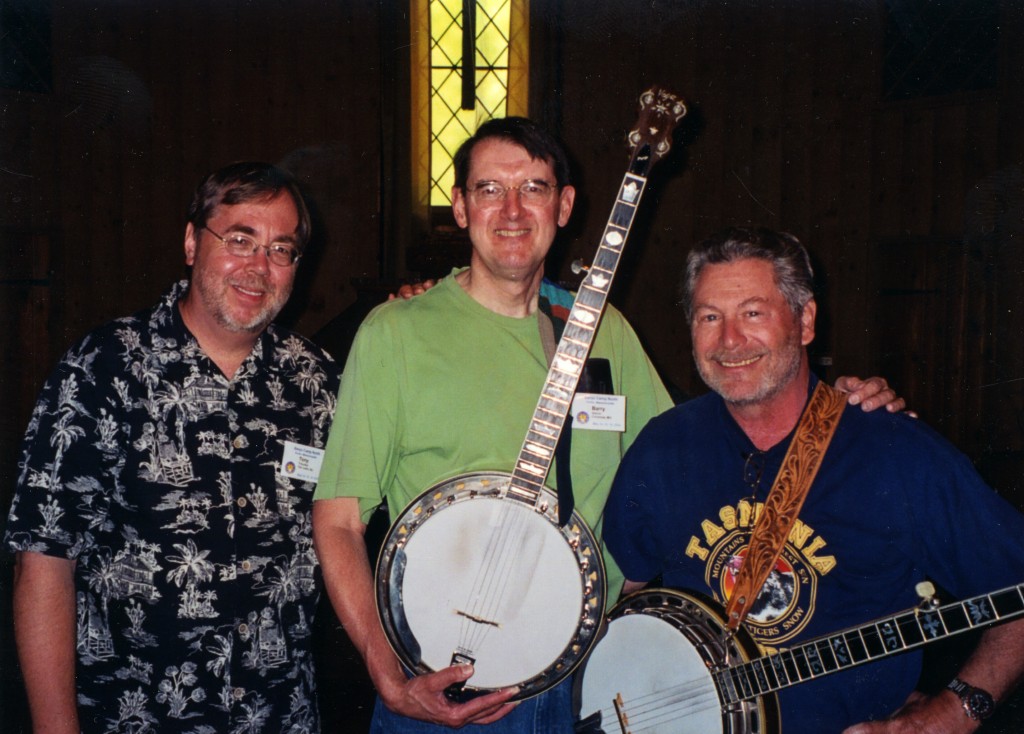
Flanked by interactive faculty at a northeastern banjo camp, the BRC founder proudly shows-off his Vega VIP banjo built in Nazareth, Pennsylvania, in 1975. Unbeknownst to most 5 string aficionados, the Martin Guitar Company manufactured Vega banjos from 1970 through 1979. Note below the “C.F. Martin” decal photographed on the back of the VIP Vega peg head. The two legendary musicians in the camp photo are banjo godfather Tony Trischka and Grammy award winner Eric Weissberg.
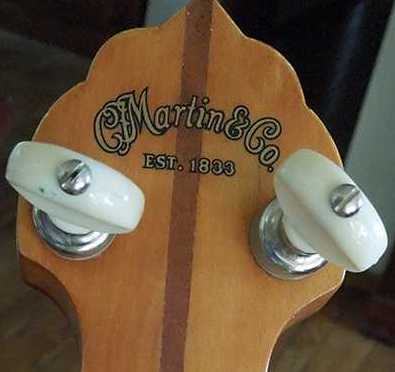
The BRC Archives contain the serial numbers of these unique Vega-Martin banjos. These data were generously provided to the BRC founder in 2000 by the family owned Martin Guitar department of history.
From its early Boston beginnings, the Vega Banjo Company made splendid and now vintage instruments, including the Earl Scruggs signature model he endorsed in the 1960′s. After its Martin Guitar era, the Vega brand name ownership was sold overseas, and the banjo line fell into obscurity. Kudos to Greg Deering who rescued the Vega brand name from extinction in 1989 and restored it to greatness. (BTW, for additional postings select “Vega Martin Stories” on the homepage menu or enter “Vega Martin” in the search engine. )
Anatomy of the Early Vega Martin Banjo
When C. F. Martin Co. bought the Vega banjo line in May of 1970, hundreds of parts were inherited from the Needham Heights factory near Boston. For several years, the Vega Martin banjo was an amalgam of parts from Massachusetts and Nazareth, PA. Old 6 digit Vega serial numbers persisted on a yellow sticker on the inner pot until production was moved to Pennsylvania in 1972. 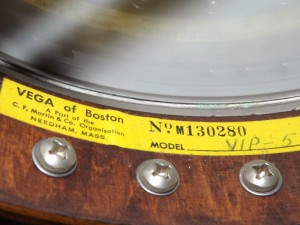
Thereafter, C. F. Martin installed a serial number decal on the inner rim beginning with #2 and on through #1945. Note the unique cluster of 3 sound apertures spaced around the tone ring of the below VIP-5 model owned by the BRC founder (SN 1364).
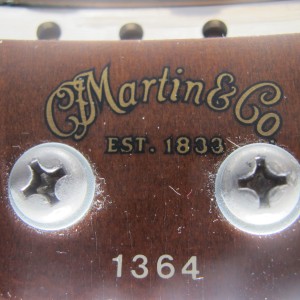
Close study of the flange can sometimes reveal, however, that it is left-over Vega hardware from the Needham Heights factory.
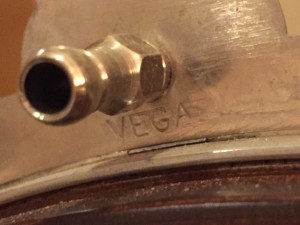
Allen screws at the neck/pot junction and a tube connecting rod (not shown) are design features from the 1960`s in Boston . Over a period of several years, the Vega line morphed into a uniquely featured Vega Martin instrument.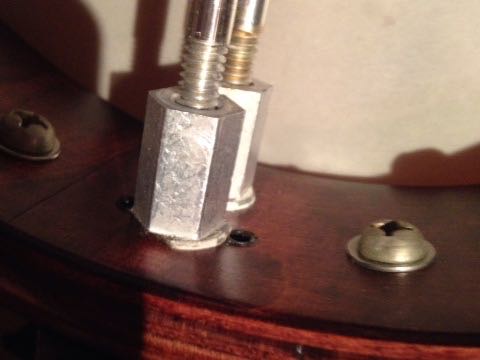
A Lone (Pre Vega Martin ) Banjo at the Art Museum
The Metropolitan Museum of Art in NYC recently showcased an exhibit of pre-1900 Martin guitars.
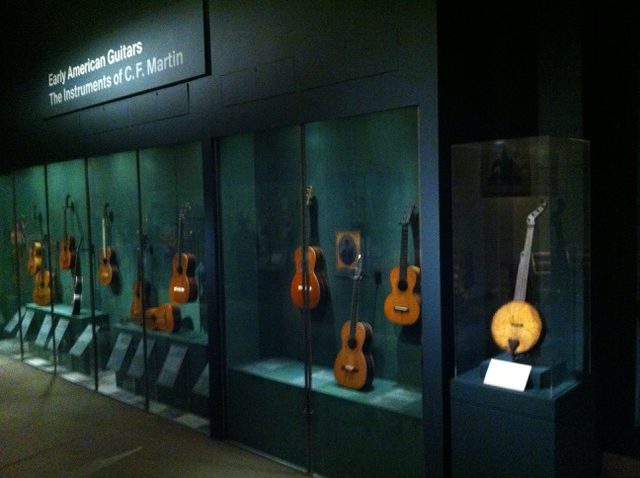
This fascinating collection of vintage stringed instruments chronicles luthier C.F. Martin`s transition from traditional Spanish, Viennese, and Renaissance structural features towards innovating a modern acoustic guitar with a unique cross brace design.
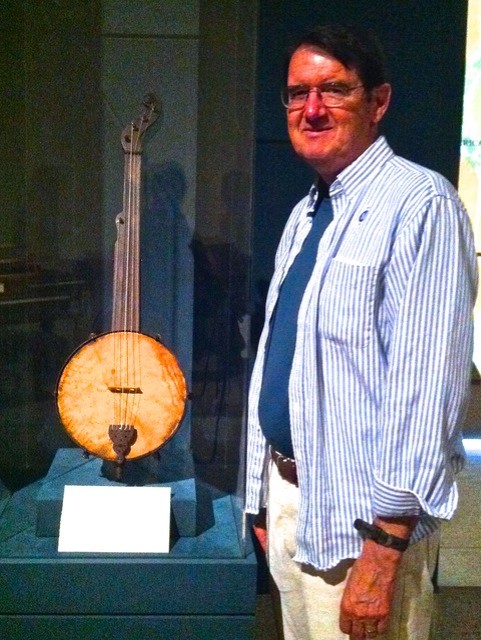
Although the Martin Company did not manufacture Vega banjos till a century later, a solitary banjo from the mid 19th century is appended to the exhibit to display parallel innovation in the instrument because of its increasing popularity during that era.
This 5-stringer was manufactured circa 1845 in Baltimore, MD, by luthier William Boucher, Jr.. He is credited with being one of the first banjo-builders to install side brackets with hooks to adjust the tension of the head.
The C.F. Martin Company acquired the Vega rights from the Bostonian Nelson Family in May of 1970 and sold the franchise overseas in March of 1979.
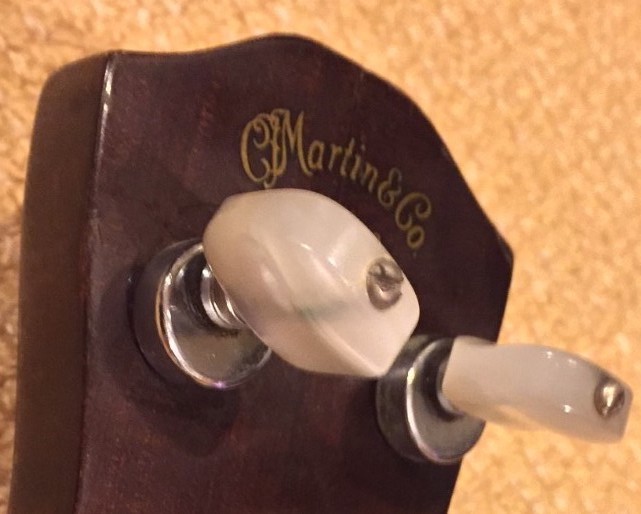
Ironically, C.F. Martin briefly built a lightweight tenor banjo between 1923-26 to compete with Vega and other manufacturers whose heavier and more popular banjos had greater tone, volume, and sales.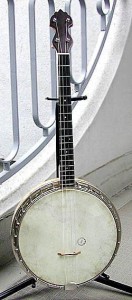
An example of one of these 4-stringers from the 1920`s is still in the C.F. Martin Museum collection. The back of the peghead of these rare banjos is imprinted with a C.F. Martin stamp.
The Banjo Rehabilitation Center archives contain the serial numbers and dates of manufacture of the Vega-Martin banjos made in Nazareth, PA, during the 1970`s. Data from these logbooks are available per e-mail request from the BRC founder.
A Vega/Martin folktale from the BRC mailbox:
Dear Reader,
Thanks for the photo of your Vega/Martin Pro-5 banjo. It is a beauty. Of note, when the “Professional” 5-stringer was made in Boston in the early 1960`s, it had square MOP inlays with dots on the neck compared to the nicely designed inlays on your fretboard and seen in the 1966 catalogue. In the 1970 transitional Vega/Martin banjo catalogue, their “Pro” model line is conspicuosly absent; and instead, is seen a nearly identical twin “Bobby Joe Fenster” style banjo named after a fictitious nerdy folk musician invented by Martin in 1967 as an insider marketing joke.
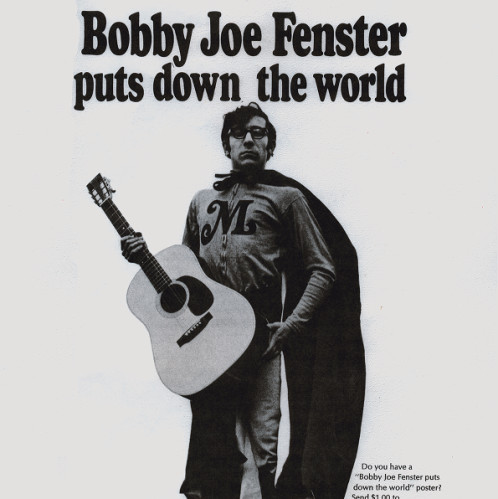
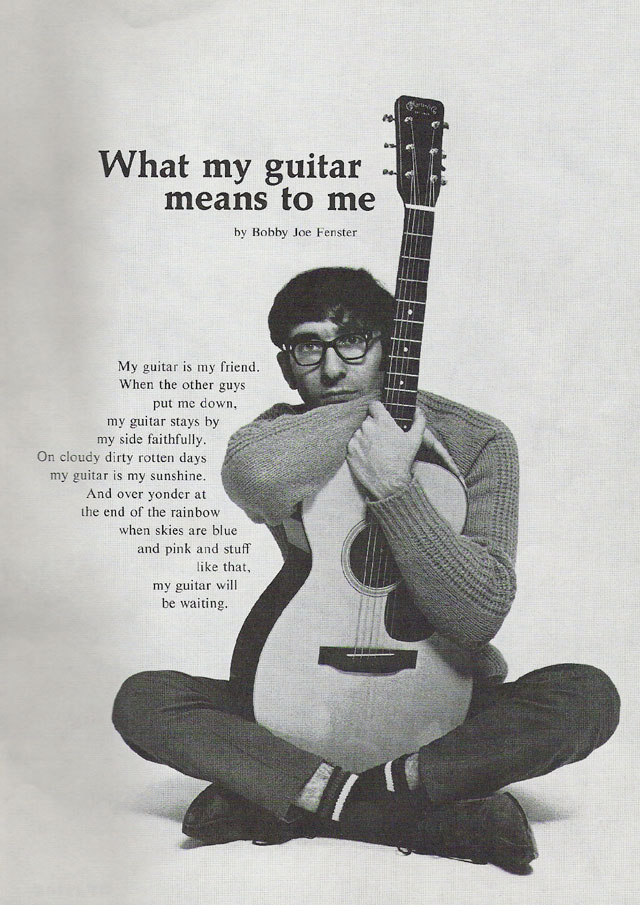
In the Martin SN files, banjo #1302252 manufactured in 1971 is designated as a “BJF-5 (Pro)” style instrument. Although C.F. Martin did not develop or cultivate such a banjo line, a dozen such BJF-5 entries are recorded in their shop files from 1971-1972. The handsome Professional-5 model with an upgraded tone ring and rim re-appeared in the 1972 Vega/Martin banjo catalogue- but no sign ever again of the short lived BJF-5 stringer. 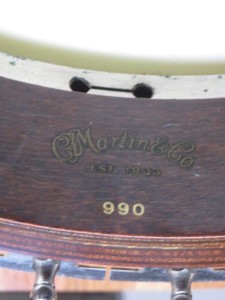
The “Pro” model initially featured a “Tube-a-phone tone chamber rim” which evolved into a tone ring with “exclusively designed audio apertures” machined into a dogbone/barbell configuration.
The `Martin Guitars: A Technical Reference` confirms that the BJF-5 banjo was a thinly disguised Pro-5 not unlike yours . To unravel most of the curious mystery of the legendary Bobby Joe Fenster, please scroll back to the Sept. 12, 2014 homepage posting devoted to this interesting figure from the annals of Vega Martin banjo history, or just enter “fenster” in the search engine on the home page. In the meantime, keep on pickin` that Pro-5. Barry
A Legacy from the BRC Mailbox: A Regal Lineage Concludes…
The highly ornate Vega Vox IV banjo with serial number #1969 was the final officially documented banjo manufactured by C. F. Martin in Nazareth, PA. , circa 1978-79.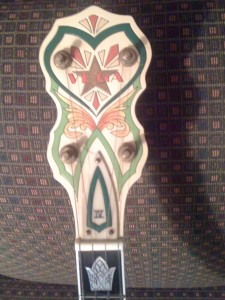
The Vega Vox model was a 4 string gem that featured a brass tone ring. The resonator was hand-painted, and fancy engraved pearl inlays adorned the ebony fingerboard. The peg head engraving and paint motif matched the resonator. 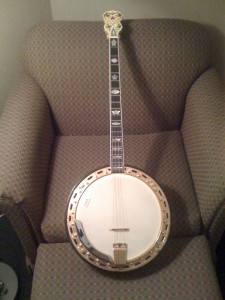
As C.F. Martin was winding-down its banjo production, the metal engraving was subcontracted to Liberty Banjos.
Thanks to BRC Consultant and Vega Vox scholar Dr. Ron from everyone at the BRC for providing representative images typical of this historic crowning jewel (see below correspondences #24).
Lots More From the BRC Mailbox:
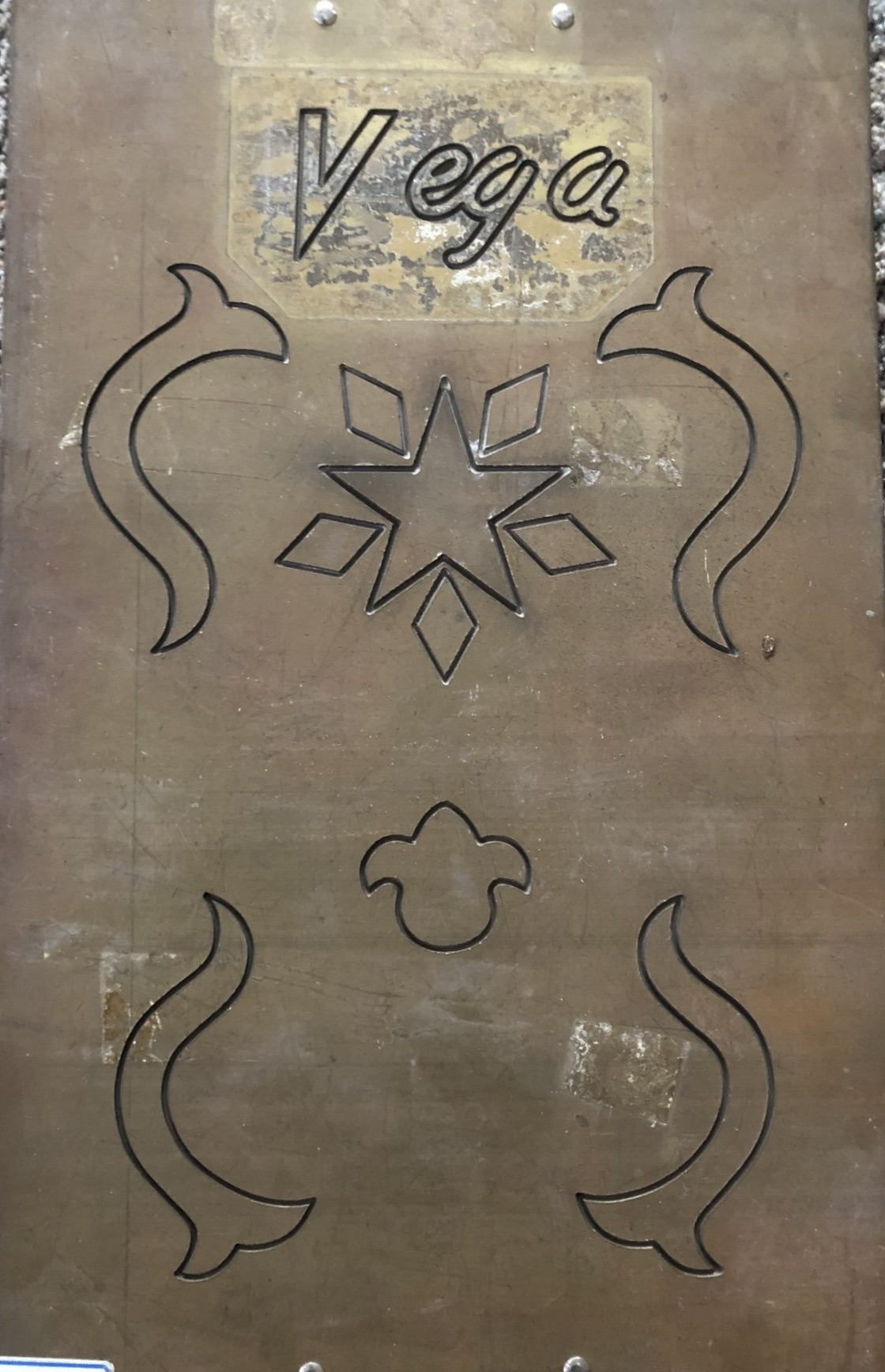
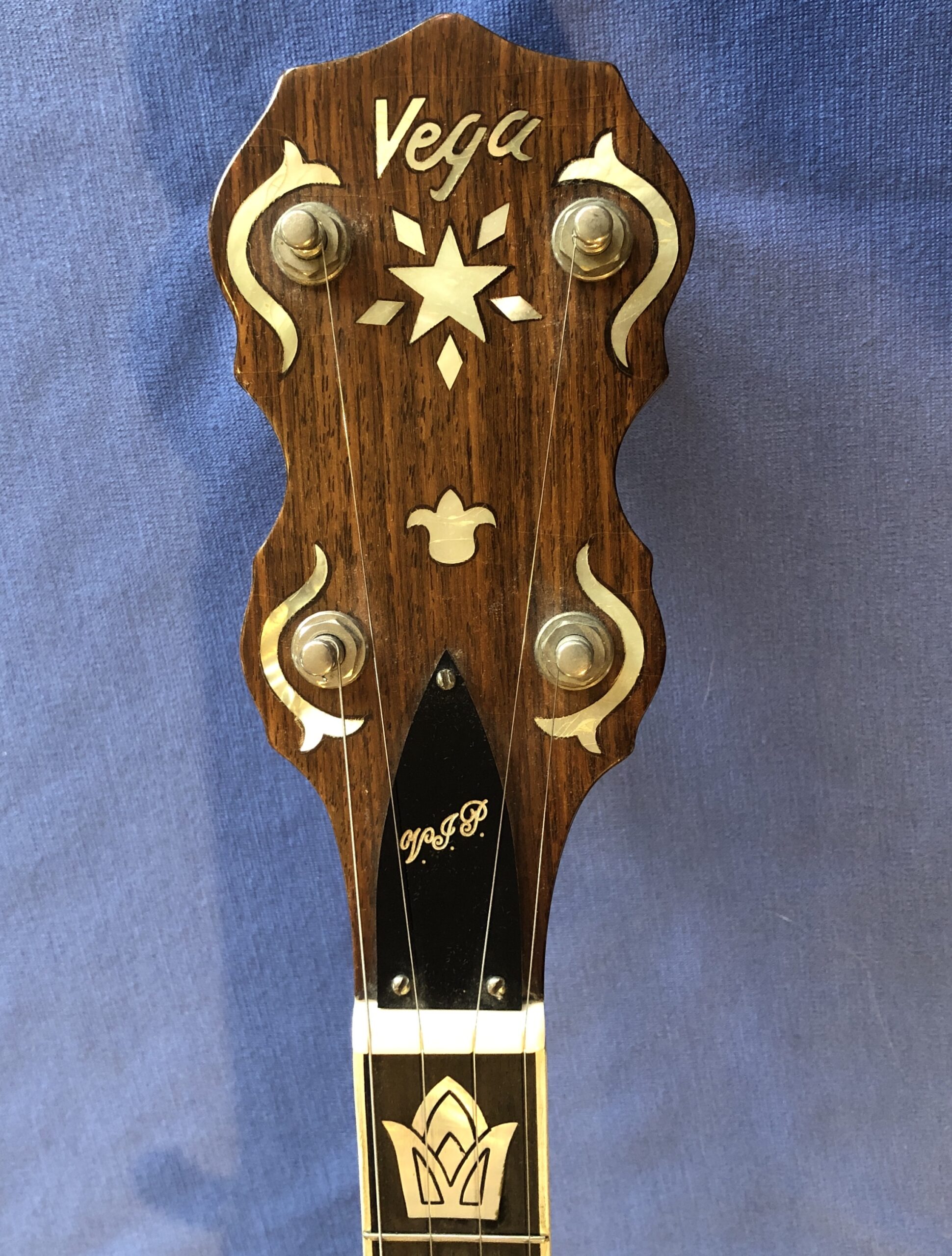
S.C. says:
Date: Oct. 7, 2021
Subject: Help with ID of Vega Banjo please
Hello-
Just came across your site, I was wondering if you would be able to help identify what model Martin Vega banjo that I have, I believe it is from the 70’s. Have a bunch of pics I can forward, any particular area to focus on that would help?
Thanks, S.C.
BRC replies:
Oct. 7, 2021
S.C.- Thank you for your query to the BRC. Please take detailed photos of your banjo inside and outside. Look for decals and a serial number on the interior of the rim to help document its story. With appreciation, Barry
BRC says:
Oct. 8, 2021
S.C.-Thank you for the prompt and detailed photos of your banjo. It is a Vega Martin model VW-5 called a “Vega Wonder” and sometimes referred to as the Wonder-5. It was manufactured in Nazareth, PA, in mid 1973 per shop order # 2154. C.F. Martin built 561 VW-5 banjos in the 1970`s.You can learn more about this VM instrument by browsing my <banjorehab.com> website for the postings on 6-19-21 and 1-16-21, or just enter the word `wonder` in the search engine. Thanks again for your query. Have a restful weekend and be well, Barry
S.C. replies:
Oct. 8,2021
Wow! What a wealth of information! Thanks so much I’ll get back to you if any further questions. Have a great weekend as well.
Best, S.C.
I inquired on Banjo Hangout about information on a Vega banjo acquired from a friend. He was told that it was made by Martin, but I do not find any Martin labels. It was recommended by Bob Smakula that I send some photos to you and that you might have more information. Photos –https://drive.google.com/drive/folders/14ES67V1VHbMR-GfbQpvWWGD1RUJrtyTv?usp=sharing
Dear T.B.-Thank you for your query to the BRC and the above photo link. Your banjo appears to be a hybrid assembled sometime in the 1980`s after C. F. Martin sold the Vega franchise overseas to the Galaxy conglomerate in 1979. The Vega line was then marketed in the USA by TMC Company (Targ & Dinner 20 Century Music Company). Your banjo neck is from a Martin Tu-Ba-Phone 5-string banjo as advertised in a Martin flyer circa 1978, and the pot also looks like a left-over rim inherited from the Nazareth, PA, company. TMC marketed this standard neck Tu-Ba-Phone banjo as item No. VT2NRC in its 1979 catalogue, and Galaxy went bankrupt in a few years. The fascinating wooden pie (sectioned) resonator is probably inherited from the Boston era Vega inventory. The Vega Company reportedly introduced the first wooden sectioned “pie” resonator in mid 1923 for their Vega Professional 4-stringer. This unique style resonator was very popular for many years, and it still has value as a vintage part. It is not to be confused with the metal pie plate or “hubcap” resonator manufactured by Elton in the 1930`s. Deering purchased the Vega franchise in 1989 restoring the line to greatness. In recent years, Deering recreated and markets its own Vega Professional 4-stringer model with a classic wooden pie sectioned resonator. Hopes this helps. Be safe, be well, keep on picking. Barry
Hello, I just stumbled onto this site today 4/16/20. This is a super site for banjo players and owners. I bought a Vega Martin 5 string some time in 2000. I knew nothing about it until I found this site. It look and plays great. I would like to know a little more about it. The label on the peg head reads “Martin & Co” and inside the rim reads “Martin & Co and the number 993”. One of the 2 rods inside rim is a larger diameter then the other one. The smaller one has 2 small set screws installed on either side of the rod to adjust the neck heel . Is has a hard case with blue interior. Is it possible to tell me what model or style and year it was built also the value? I would send pictures but was not sure just where to post them. Thank You for your time and web site. John, just an old Missouri banjo picker transplanted in Arizona.
John- Thank-you for the detailed photos. Your 5-stringer serial #993 is one of six Pro-5`s manufactured per Shop Order # 2211 in mid 1974 by C.F. Martin in Nazareth, PA. Per the 1971 Martin price list, the recommended retail price back then was $545 with out case which cost another $68 for the hard shell version. The evolution of the “Professional” model dates back to the Boston 1963 Vega catalogue that featured the first “Pro” model banjo that looked like an inexpensive version of the “Earl Scruggs” model that Vega offered at that time. Both of these models had block mother of pearl inlays, with fewer inlays appearing on the new scaled-down “Pro” fretboard. The Pro II model was advertised in the 1966 Vega catalogue with an up-graded and fancy mother of pearl inlay pattern as seen on your banjo. The 1968 Vega catalogue described the Pro II appointments as including a bell brass tone ring with exclusively designed audio apertures, a ten ply wood rim, a three-piece maple neck, a resonator of curly maple, a notched brass tension hoop, nickel-plated hardware, and a shaded mahogany finish. In 1970, C.F. Martin purchased the Vega brand and briefly marketed the so-called “Bobby Joe Fenster” banjo which was a thinly disguised Pro-5 endorsed by a fictitious banjoist as a somewhat mirthful marketing ploy. In the 1972 Martin catalogue, the “Professional” appears identical to yours, but it is absent from the 1976 catalogue. The mother of pearl inlay fretboard pattern in your Pro-5 is similar to that found in the popular VIP-5 banjo, but the latter has single-stripe engraving in the mother of pearl. After Martin sold the Vega line to Galaxy in 1979, this generic mother of pearl pattern remained the same in the VIP model but had double-stripe engraving on it. During the Vega Martin era, C.F. Martin manufactured 100 Pro-5 banjos including the temporary “Bobby Joe Fenster” variation. The larger connecting rod inside the pot is a spare part inherited from the Boston days of the Vega company. The tiny screws adjacent to it are an adaptation by the Vega franchise to afford fine-tuning of the side-to-side alignment of the neck. Because so few Pro-5`s were manufactured in Nazareth, it is difficult to gauge the worth of your banjo these days. My estimate would in the neighborhood of $1.5K depending on condition. Hope this helps. Be safe, be well. Barry
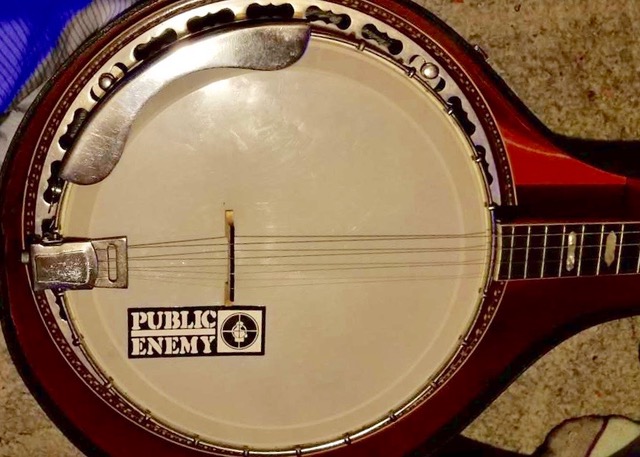
Samantha– Thanks for the extensive and helpful photos of your above banjo. In 1979, Martin sold the Vega brand to the Asian conglomerate Galaxy. Vega banjos were then marketed in the USA by TMC (Targ & Dinner Music Company). Your instrument is a tenor arch top 4-stringer made in the early 1980`s. The Vega banjos in the TMC catalogue were identified by serial numbers only with no model titles or nicknames. Your banjo is item # VB120C which sold for $360 back then. Galaxy went bankrupt in a few years, and the Vega brand was purchased in 1989 by Deering in California who restored the instrument line to greatness. Hopes this helps and thanks again for the detailed pictures. From the BRC, Barry

Well, this is a hybrid banjo, and doubtful that is a Galaxy banjo. The rim and shoe screws/washer are likely homemade/cut down and tone ring is not Galaxy stock, but more of a Gibson knockoff. The “Eddie Peabody Model” was actually made by Vega of Boston from 1966-ca. 1969, probably initially at the 40 Leon Street factory the Needham Heights (just before the sale to Martin). It was a student model that Eddie convinced long time friend and Vega owner/president to make positioned as a lower cost alternative to the Vox I/Professional II…it was an upgrade over the Little Wonder/Ranger banjos. They made both tenor/plectrum and five-string models. The differentiating feature is the deeper resonator than the VIP/Pro II/Osborne/Scruggs Mk II/Bobby Joe Fenster standard resonator models—not quite as deep as the Vox and not top tension (standard hook and nut with Pro II flanges). It did not have a tone ring or simply a steel ring like the Wonder, to keep the cost down. But, the neck had the upgraded crown inlay pattern like their mid range banjos, and originally a paddle peghead design (the new scroll design appeared in 1968). They all had yellow serial number stickers.
Reply to BRC,
Barry, I want to thank you very much for the research on my Vega. Being unable to find anything on the internet, I began to think I had been scammed. The tone ring really had me confused! It looked like it belonged on a Gibson. Many thanks to you and your friend Ron for putting me straight. Jack
Tim says:
April 30, 2019
GREAT FORUM. Recently purchased a Vega Vox iv plectrum banjo. Serial number 115831 on a yellow strip built in Boston Mass.Wondering when it might have been built?
-
Ernie- It would be helpful if you could send a photo of your yellow sticker, as I suspect that your Vega Vox IV was manufactured in Boston in 1964 after Vega reconverted to a six digit serial number during the pre- C.F. Martin era. This email will be copied to my Vega Vox scholar Dr. Ron for his insights and comments.
From the BRC, BarryReply from our Vega Vox scholar Dr. Ron
Hi Ernie,Congratulations…and, welcome to the VegaVox family!
As Barry indicates, a photo of the yellow sticker will be helpful here. The problem is that the serial number labels at this time had printing errors, where the first numeric digit was omitted. Typically, the number would be preceded with an “A” (indicating an adjustable truss rod) followed by a six-digit number. I have attached photos comparing the label printing difference.
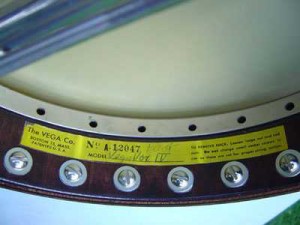
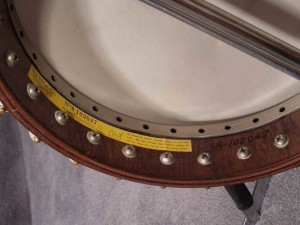 The five number labels were found in banjos made from 1962 through February 1964, involving serial numbers A10300 through A12400. I am assuming someone may have penciled in an extra “1” on yours, but my best guess is that it was made sometime in the last half of 1963 (A12130 was the first banjo produced in Jan ’64). So, your banjo is likely either a late 1963/early 1964 model (Vega “model years” ran from Oct 1st-Sept 30th at the time, much like automobiles). Most likely, your banjo has a paddle peghead still with Kluson tuners, block MOP engraved fingerboard inlays, and an updated resonator design with black bindings and a fleur-de-lis added under the engraved star “De-Luxe Vegavox” on the back (brand new on the 1963-model).
The five number labels were found in banjos made from 1962 through February 1964, involving serial numbers A10300 through A12400. I am assuming someone may have penciled in an extra “1” on yours, but my best guess is that it was made sometime in the last half of 1963 (A12130 was the first banjo produced in Jan ’64). So, your banjo is likely either a late 1963/early 1964 model (Vega “model years” ran from Oct 1st-Sept 30th at the time, much like automobiles). Most likely, your banjo has a paddle peghead still with Kluson tuners, block MOP engraved fingerboard inlays, and an updated resonator design with black bindings and a fleur-de-lis added under the engraved star “De-Luxe Vegavox” on the back (brand new on the 1963-model).The Vega Company manufactured of this era were assembled at the 40 Leon Street factory in Boston from 1961-1966, and subsequently at the 155 Reservoir Street facility outside Boston in suburban Needham Heights from 1966-1971(C. F. Martin acquired the company in May 1970 and continued some manufacturing/assembly there until moving fully to Martin’s factory in Nazareth, PA). When C. F. Martin took over Vega in 1970, they dropped the A-xxxxxx serial numbers and replaced it with M-xxxxxx series, until starting a new four digit numbering system in 1972 at the Nazareth factory.
Hope this helps.
Cheers, Ron
Wow, I glad to find your website! What a wealth of banjo information you have.
I have a VV IV T tenor SN: M130298 which I purchase used about twenty-five years ago for $2,000. A previous owner had deeply scratched a Social Security number into its heel. I had Renee Karnes carve the heel with a VV flower and leaf design to get rid of the SS #. Of course she did a beautiful job with it including turning its blond color into a brunette! Its paper label says it was made by Vega of Boston, part of the CF Martin Co. but it does not have the CF Martin decal on the back of the peg-head. Just wondering if you have any interesting data on this ax. I play it weekly (weakly) on Monday nights at restaurant in Anaheim, California and love its sound.
-
Dave- Thank you for your kind words about the website and the narrative about your Vega Vox IV tenor banjo. When C.F. Martin purchased the Vega brand in May of 1970, the Martin factory in Nazareth, PA, began to re-tool for banjo production. During this transitional period, Boston parts were shipped to Nazareth for assembly, and Martin pre-fixed the traditional six digit Vega serial number with the letter `M`. Your tenor 4-stringer was built in early 1972 per Shop Order 2051. A few months later, the old six digit number system was replaced with new sequence starting with #2 and progressing sequentially to a four digit number over the ensuing years. The Vega Vox IV of that era featured burnished gold-plated parts, engraved flanges, an all white pyralin deep resonator with elaborately engraved back and sides, a fretboard with fancy pearl inlays, and an engraved and colored scroll shaped peg head. It listed for $1310 in the 1971 VM price brochure and a carved heel was extra. Deering now owns the Vega brand, and it is rumored that they may revive the deep resonator design. From the BRC, Barry
Reply from our Vega Vox scholar Dr. Ron:
The information looks just fine—there were yet a number of the Mxxxxxx series banjos still made in the Needham Heights factory outside Boston. I actually picked up a banjo that had a resonator that was sitting on the shelf in that 1970-72 period as Martin was transitioning and shutting down the factory there.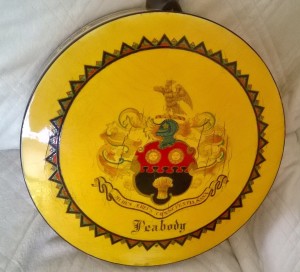 I’ve attached a photo of that “Coat of Arms” resonator next to my Vox V—it was a spare they had made for Eddie Peabody.
I’ve attached a photo of that “Coat of Arms” resonator next to my Vox V—it was a spare they had made for Eddie Peabody.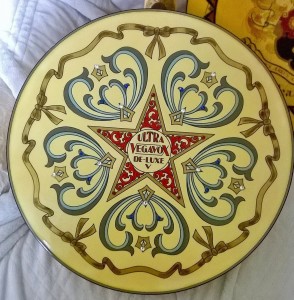 Thought you might enjoy an article in All Frets from my good friend and American Banjo Museum curator, Johnny Baier, “An Ode to the Vega Vox”—I’d like to think my bad influences have moved him over to the “dark side” as he is now a happy owner of his own deep resonator tenor with a calfskin head (it sounds fantastic).Another side note, Greg Deering has made two prototype Voxes already…I have played one of them, which is basically an identical design to the 1967 Vox I with a paddle peghead and crown inlays. I can’t find that picture, but I’ll see if I can locate it, as someone else may have sent it to me playing the banjo out at a festival in Arizona. He uses the one piece neck design typical of the other Deering models with the SN stamped on the back of the peghead. Greg also originally hand made the round hole Tubaphone tone rings, but now they have a fairly well honed machine manufacturing process. This Vox uses brass (rather than the late model Vega/Martin aluminum) hex nut shoes for the tension bolts, and thinner dual brass coordinator rods (again, instead of aluminum). Also, Deering uses a 3-ply 1/2” rock maple rim, compared to the 5/8” 10-ply rim typically found in most Martin Nazareth produced Voxes in the 1970s. Tony Trsichka wants Greg to make a 5-string model, much like Vega did on very rare occasions in the late 1950s/early 1960s.
Thought you might enjoy an article in All Frets from my good friend and American Banjo Museum curator, Johnny Baier, “An Ode to the Vega Vox”—I’d like to think my bad influences have moved him over to the “dark side” as he is now a happy owner of his own deep resonator tenor with a calfskin head (it sounds fantastic).Another side note, Greg Deering has made two prototype Voxes already…I have played one of them, which is basically an identical design to the 1967 Vox I with a paddle peghead and crown inlays. I can’t find that picture, but I’ll see if I can locate it, as someone else may have sent it to me playing the banjo out at a festival in Arizona. He uses the one piece neck design typical of the other Deering models with the SN stamped on the back of the peghead. Greg also originally hand made the round hole Tubaphone tone rings, but now they have a fairly well honed machine manufacturing process. This Vox uses brass (rather than the late model Vega/Martin aluminum) hex nut shoes for the tension bolts, and thinner dual brass coordinator rods (again, instead of aluminum). Also, Deering uses a 3-ply 1/2” rock maple rim, compared to the 5/8” 10-ply rim typically found in most Martin Nazareth produced Voxes in the 1970s. Tony Trsichka wants Greg to make a 5-string model, much like Vega did on very rare occasions in the late 1950s/early 1960s.
Thanks for posting the information on Martin mage Vega banjos. I have found it helpful over the years. Today I purchase Vega PS-5, serial number M-130259. The label indicates the banjo was made in Needham, MA, but the Vega company was owned by the CF Martin guitar company. If there is any other interesting information about the instrument you care to share from the Martin log book, I would be most appreciative.
-
Bob- Thank you for your kind words about my website, and I reply with compliments to your luthier shop with which I am familiar. By history, C.F. Martin purchased the Vega company on May 5, 197O. While the Martin factory in Nazareth, PA, retooled to build banjos, interim yellow stickers were affixed to the inner rims of Boston banjos citing the merger and identifying the model of the instrument (which was inscribed by pen). By early 1971, Martin began to assemble banjos from Boston-made parts in Nazareth using the Vega six digit serial number system prefixed with the letter “M” for Martin and beginning with Shop Order 2001. This workshop numbering system continued uninterrupted to #2355 in 1977 when the banjos went overseas for assembly. C.F. Martin initiated its own serial number system in early 1972 which ran sequentially from #2 through #1945. Your PS-5 Pete Seeger long neck # M-130259 was assembled in Nazareth in early 1971 per Shop Order 2012. Martin built only 101 PS-5 long necks. In the Martin price list of 1971, it is listed at $488 without case. Per my files, the Pete Seeger long neck first appears in a Vega flyer in 1961 for $309. It appears in the transitional Vega/Martin product list of 1970 and lastly in the 1972 Vega Banjo Catalog (The CF Martin Organization). The PS-5 is not seen in the 1976 Vega Martin catalog but is replaced by the No. 2 Tu-Ba-Phone XL long neck. There are some folklore stories why the Seeger banjo was discontinued. Of note, the PS-5 had the `famous Vega “Tube-a-phone” tone ring rim`, a 3 piece ebony fingerboard, pearl dots, a neck-tension rod, nickel-plated rim parts, a shaded mahogany neck, and a 10 ply maple rim. The tonering, bracket band, and notched tension hoop were “all made of vibrant bell brass (Not die cast metal)”. A nice banjo- enjoy. Barry
Rowdy says:
First let me thank you for this amazing well of information!
My Vega F-VIP #1456 got chosen from the ’72 catalogue in spring of ’76 in a music shop in Stuttgart / Germany, and was delivered only about ten weeks later. The build quality is quite immaculate, both wood and hardware. Neck and rim look a lot like made by Martin craftsmen, and it arrived set up perfectly. Aside a changed bridge it remained un-modified and rarely played until about two years ago, as by the time I had bought it, I more and more began concentrating on the guitar.
A couple of years ago I started to develop increased interest in clawhammer style, and with all the lessons available online nowadays, finally I’m finding myself back on the tracks. That’s when I decided to modify this rather bluegrassy bright (and plenty of loud) sounding “Folk” banjo a bit. This did include the instalment of a “Fiberskyn” head to mellow down the tone somewhat, of a geared 5th string tuner, and of a (very nice) tailpiece to replace the chrome plated Waverly (everything else nickel). I also did replace all of the cheapish plastic knobs with ivoroid ones of much better quality.
Therefore it became dissembled. The banjo is featuring an interesting mix of particulars: The connecting rods are of the (much earlier?) aluminum variety, one slim one large, with the larger one closer to the head. It’s also featuring the two small hexagon bolts inside the rim (Quite handy for fine-centering the neck!), though, as said earlier, neck and rim look a lot like Martin quality. It also features the four digit SN imprinted into the outside of the “holes in groups of three” tone ring, clearly done before the plating, and visible only when dissembled.
I’ve got a couple of pictures in case of interest, but I’d need a mail-address for sending, me supposing. I’ve also got some remaining parts from the renovation process I’d happily like to donate, including the original chrome-plated brass tailpiece, and a couple of almost unused heads.
Greetings from Stuttgart,
Andreas
-
Andreas- Thank you for the historical narrative on your banjo and the detailed photographs. Your F-VIP (Folk-Very Important Player) banjo #1456 was manufactured in Nazareth, PA, in mid 1975 in a lot of 3 such instruments per Shop Order 2274. It is a somewhat rare bird, as C.F. Martin built only 20 F-VIP 5 stringers, and to my count 11 were made in Pennsylvania per the shop log book. The other 9 were likely shipped to Canada or Japan for assembly after 1977. The F-VIP is first mentioned briefly on a front page of the 1970 Vega Martin catalogue, and it retailed for $490 in the VM price list of 1971. It is mentioned again on a back page of the 1972 catalogue. In the final VM 1976 catalogue, the F-VIP is displayed in full advertising detail.
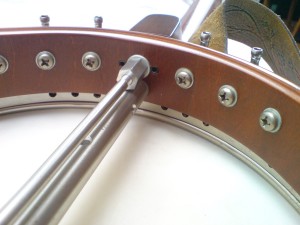
Of note, the tubular connecting rod and the Allen head screws seen in your banjo pot are design features left-over from the Vega era in Boston.
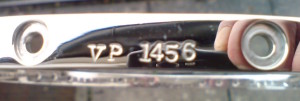
The SN 1456 on the outside of your tone ring is a fascinating and new discovery to me, and we VM banjo owners should inspect our tone rings for this hidden marking the next time a head gets exchanged.
Thanks again for your post and pictures and kind comments about the website. From the BRC, Barry
gary says:
Barry, i have an extended neck (25 fretts) Vega/Martin banjo with a serial number of 80. The serial number is stamped in the wooden rim below the Martin decal. What can you tell me about my instrument? Thank you so much!!!
Gary
-
Gary- Thanks for your query. Vega Martin long neck PS-5 banjo SN 80 is one of eleven Pete Seeger 5-stringers manufactured in Nazareth, PA, in mid 1972 per Shop Order 2098. C.F. Martin made 101 of the PS-5 instruments which listed for $488 without case in the final V/M price list in 1971. In my files, the PS-5 is seen in a Vega (Boston) flyer in 1961 where it lists for $309. In the 1960`s, the PS-5 featured a 3 piece ebony fingerboard and a “Tube-a-phone” tone ring of bell brass and a 5 ply maple rim. C.F. Martin upgraded the maple rim to 10 ply after purchasing the Vega/Boston franchise in May of 1970. The PS-5 is advertised in the 1970 and 1972 Vega/Martin catalogues but is absent from the 1976 catalogue where the No. 2 Tu-Ba-Phone XL long neck premieres instead. In general, the Boston made Pete Seeger long neck banjos seem to command a greater collectors` interest than the ones manufactured in Pennsylvania. Again, thanks for your post. From the BRC, Barry
Gary says:
Barry, thank you so much!I love the story. This is a beautiful banjo!Thanks again!Eddie says:
Fantastic site with wonderful information. I own Martin Vega Wonder serial no. 721 which I have had a number of years. I’m curious to know if it is possible to learn whether this banjo came from the factory with a resonator or was originally sold as an open back. Any and all information you may have on my little banjo will be greatly appreciated!
-
Eddie- Thanks for your query and kind comments about the website. Your VW-5 model “Vega Wonder” banjo SN 721 was manufactured in Nazareth, PA, in late 1973 per Shop Order 2181. The Wonder series of instruments featured a metal tone ring, white fingerboard binding, a heavy notched tension hoop, a 10 ply rim, a 3 piece maple neck, a blackwood fingerboard, pearl dots, an armrest, and a factory-installed resonator with four section metal tone flanges. It retailed for $345 in the 1971 Vega Martin price list. Your VW-5 resonator banjo is not to be confused with its cousin the open back FW-5 model “Folk Wonder” which retailed for $280. C.F. Martin manufactured 561 VW-5 banjos but only 124 FW-5 instruments. Both the VW-5 and FW-5 appear in the 1961 Vega ((155 Columbus Ave., Boston, MA) catalogue but featuring a 5 ply rim in the early design. The open back Folk Wonder 5-stringer does not appear in the 1976 Vega/Martin catalogue where the Vega Wonder resonator series is still advertised featuring a brass tone ring and ebony fingerboard. Hope this helps and best wishes from the BRC, Barry
Mark says:
Hello and thank you so much for your hard work and dedication. I don’t play any instrument right now. I have 5 different stringed instruments that just keep finding me, and I was nervous to take it apart so I could look at the serial number. very carefully, I did and it’s four digits # 1450. it looks very good to me as far as the condition, it’s just old and kind of dirty. so it does say Martin on the back and it’s vega on the front.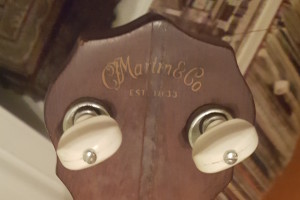
it has five strings and if you would be so kind let me know something about it and if someone you know wants to play it, I guess it would be better off with them; or I will go take lessons I suppose. thanks for your help and keep up the good work. what I know about banjos right now I learned from you!! Thanks again.
-
Mark- Thank you for the very helpful series of photos and your kind comments about the website. According to the C.F. Martin logbook, banjo SN 1450 was an entry level “Wonder” model 4 string plectrum banjo made in 1975. I have two theories about your instrument. After the difficult 1977 luthier strike at the C.F. Martin factory in Nazareth, PA, parts were shipped overseas to Japan and Canada for assembly. Serial number assignment and record keeping fell into disarray from 1977 to 1979. Your banjo may be a hybrid from that era. The Vega brand was subsequently sold overseas in 1979. My other theory is that the pot, which bears a C.F. Martin decal, is the original pot for the plectrum 4 stringer SN 1450, but the neck was replaced after production with a 5 string neck by a previous owner. The tailpiece does not look original, but the dual connecting rods are typical of the Martin design. Lastly, the banjo could be cleaned-up and refitted at a local music shop, or referred by the shop to a nearby luthier for repairs; and you would have a workable starter banjo for taking some exploratory music lessons. Give it a try and good luck. Hope this helps. From the BRC, Barry
Eric says:
Hi guys, great website. Hey, I’ve got a Martin Vega Tubaphone 5 string banjo sn# 1603 that I acquired in the mid-1980s. Do you have any information on it? I’d love to learn more about it, etc. Thanks!
-
Eric- Thanks for your kind comments about the website and prompt photos. Your T-2 instrument SN 1603 was one of five Tu-Ba-Phone 5 string banjos manufactured in Nazareth, PA, in 1976 shortly before the big luthier strike that compelled C. F. Martin to ship parts overseas for assembly. Martin built only 29 model T-2 instruments which were a reproduction of the classic Tu-Ba-Phone No. 2 Vega banjo from the early Boston era. The banjo had a 3 piece maple neck and a signature tubaphone tone ring clearly shown in the pictures that you provided.
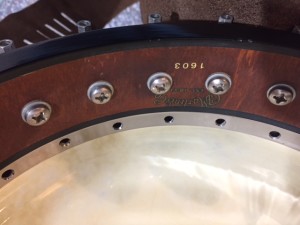
Martin did not publish retail prices after 1971, so my guess is that this up scale model sold back then for around $600. Deering owns the Vega brand name nowadays, and its T-2 lists for $4149.
Hope this helps, and I am sending you the circa 1978 C. F. Martin Tubaphone model promotional flyer . All the best from the BRC, Barry
Eric replies to BRC:
Thank you so very much for this information! I appreciate having some of the history around my banjo and will cherish it even more knowing it is somewhat rare.
Hi! My Dad left me a Martin Vega…I’m thinking I want to pass it on to someone who’ll play it and care for it more than I can. Any help with identifying it (I can’t find a serial number anywhere) or locating buyers would be so gratefully welcomed! I live near Portland, Oregon.
-
Thank you, Barry. I really appreciate your orientation. There’s precious little information about these instruments online. So cool to have this historical data…
From: Anders in Norway
Sent: Saturday, August 12, 2017 3:09 AM
Subject: Banjo questionHi,
I tried to find your email address at your Banjo homepage without any success. I apologize for using this email to reach you, but I have a banjo question I hope you can help me with.
I got an old Vega banjo from my father. It is collecting dust since i don’t play the banjo and I am thinking of passing it on. I do not know anything about banjos but the label inside the rim says ‘VEGA of Boston. A part of the C.F. Martin & Co. Organisation, NEEDHAM, MASS. No M130097 Model: Wonder 5 St’.
It looks like the banjo is in ok/decent condition. Do you know anything of the type of banjo, year of manufacturing and value today? I would appreciate it very much.
Best regards, Anders , Norway
Reply from the BRC: Saturday, August 12, 2017 8:02 AM Anders- Thanks for your query. Your Wonder-5 string banjo #(Martin)130097 was made in Boston in early 1971 after C.F. Martin purchased the Vega brand in May in 1970 and just before the factory was transferred to Pennsylvania. The Martin log book in Nazareth, PA, begins with #130248 later in 1971. The Martin Co. dropped the 6 digit serial number system in mid 1971 and then began again with #2- #1945, although a few special banjos up to #1969 were produced. The Vega franchise was sold overseas in 1979 but reacquired in the US by Deering in 1989. The Wonder-5 retailed for $345 without case per the CFM 1971 price list. The Wonder-5 was an entry level instrument with a metal tone ring, white fingerboard binding, a notched tension hoop, a 10 ply rim, a 3 piece maple neck, a blackwood fingerboard, 4 section flanges, nickel plated metal parts, and shaded mahogany finish. Depending upon condition, it is probably worth somewhere around $750 these days. Thanks again for your post. From the BRC, BarryFrom: Anders in Norway Sent: Saturday, August 12, 2017 8:51 AM Wow,
Thank you very much for your quick answer. Very interesting to get to know all this details.
Again, thank you and have a nice weekend
All the best,
Anders
-
Hi there Folks.
A few weeks ago i bought a Vega martin 5 string banjo, tubaphone tonering, the screws to attach the shoes to the bracket band go through the bracketband but also through the rim.
The banjo is almost in unplayed condition, sounds wonderfull, the original case is also there.
serial numer is 1707. Can you tell me more like age and value? Wim
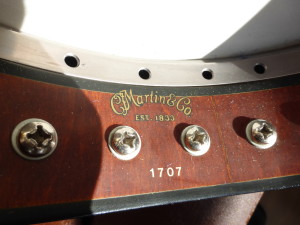 (Ed.- Note the classic Tubaphone tone ring.)
(Ed.- Note the classic Tubaphone tone ring.)
-
Wim- Congratulations on procuring such a lovely vintage instrument. According to the C.F. Martin workshop logbook, open back Tu-Ba-Phone 5-string banjo SN 1707 was manufactured in Nazareth, PA, in mid 1976. Shortly thereafter, the Martin craftsmen went on strike, and banjo parts were shipped overseas for assembly. Martin built only 29 T2-5 banjos, but no price list is available after 1971 preceding resurrection of the classic Vega T2-5 model for production. The overseas conglomerate Galaxy purchased the Vega line in 1979 and offered the T2-5 for $775 before going bankrupt in the mid 1980`s. Deering rescued the Vega line by purchasing the brand name in 1989. Deering now offers the Tubaphone No. 2 for $4149. My estimate is that your vintage instrument is worth $1500-1700. From the BRC, Barry
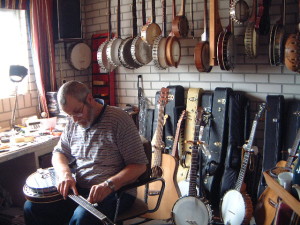
P.S. from BRC: Wim- Thanks for the great photo of your busy workshop.
John says:
March 26, 2017 at 3:36 am
So happy to find this site. my Martin/Vega PS5 #481 is about a month into my possession. I received a letter(martin memo) along with my banjo covering head adjustment, plastic “Vegalon” heads, string action, bridge and nut and neck rod adjustment dated 8/26/71…also a warranty card with the phone number 215-759-2837…ask for mike
telling me to use string type V750.
having wanted one all my adult life, this banjo is the pinnacle of my banjo collecting desires.
built in 1971, my long neck looks like it was built yesterday and all I added was a geared 5th string peg…stuck it in an American Vintage case and screwed a CF Martin brass medallion to the side. John
BRC Replies:
March 26, 2017 at 2:07 pm
John- Thank you much for your kind words about my website and letting my readers share in your joy of procuring a VM Pete Seeger long neck 5-stringer (PS-5). According to the factory logbook, banjo # 481 was one of eleven PS-5 banjos made per Shop Order # 2155 by C.F. Martin in Nazareth, PA, in 1973. Cited in the Vega price list of 1971, the last one VM published, the retail price tag was $488 without case. A total of 101 PS-5 instruments were manufactured in Pennsylvania. Of note, my Vega Martin VIP-5 banjo built in 1975 also came with a `Care of Your Banjo` memo dated 8/26/71 and a warranty that instructed the owner to call 215-759-2837 and ask for Mike (probably Mike Longworth who was C.F. Martin`s beloved historian). Although a Bluegrass resonator banjo musician, my daily practice exercises are conducted sans picks on one of two long neck Ode 5-stringers that are wife-friendly in tone. Good luck with your vintage Seeger long neck and photos of this prize would be most welcome for posting here if you are so inclined. From the BRC, Barry
Rob says:
March 13, 2017 at 11:32 am
Hello there, what a terrific Web page you guys have put together so interesting, i have a open back tenor banjo with the Martin logo and nos 916 it has the same pearl inlay as the 5 string pro it has 19 frets , i have no idea of it’s value but it has a beautiful slim neck just so easy to finger chords, cheers Rob.
BRC Replies:
March 13, 2017 at 3:46 pm
Rob- Thank you for your query and very kind comments about the BRC website. The description of your banjo serial number 916 is curious, and I will offer my theory about the instrument per the information given. In the Vega Martin shop files, banjo SN 916 is a VVI-P (Vega Vox Style 1 plectrum) resonator banjo made in 1974 in Nazareth, PA. Plectrum 4 stringers have 22 frets compared to the tenors that have 17 to 19 frets. Yes, the VVI banjos have the same inlay pattern as the VM Pro (Professional) 5 string model. It sounds like your banjo is maybe a hybrid made overseas after 1976-1977 when Vega Martin parts were shipped to Japan and later Canada for assembly. Serial numbers became unreliable during that era. Photos of the banjo might possibly shed some light on the mystery, if you are so inclined. My estimate is that the banjo might be worth $500-$700 depending on condition. Again, thank you much for your post. From the BRC, Barry
Later BRC replies:
Rob- Thank you for the below photos. The well preserved CFM decals on the rim and back of the peg head clearly document that the parts were made in Nazareth, PA, circa 1974.
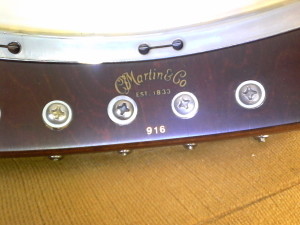
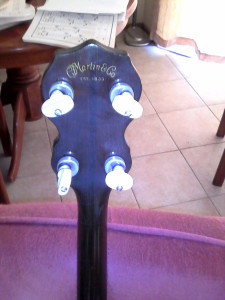
Your slightly blurry photo of the interior of the pot (not included here) show two tubular connecting rods which are left -over parts from the Vega factory in Boston. Piecing the clues together of this mysterious banjo, I suspect that is was a special order item because of the unusually disparate combination of CFM parts. Thanks for letting us see this fascinating and unique instrument. With appreciation, Barry
Reply from our BRC consultant and Vega Vox scholar Dr. Ron:
Looks like something that might have put together from parts, either inside
or outside the factory–I suspect the latter as there have been lots of Vox
“chop shop” conversions going back in time (even to the 1920s).
So, the rim and rods appear be from a Vox I, and dogbone Tubaphone tone
ring would be typical of the 1970s period under Martin (some the later Voxes
made by Vega in Needham Heights before moving to Nazareth used these, as
well as slotted Tubaphones). He could always check the stamp on the bottom
the tone ring to see if it’s a match to the rim (it should say V916).
The shoes (instead of Vox next nut shoes) and the round hook and nut
assemblies are probably from stock, as I have some still lying around at
home that I bought from Martin back then to replace on a 1929 Vegaphone
(which are slightly different). These were used on the Wonder, VIP,
Folklore, etc (non-Pro II, V-45, V-41 styles).
This is a stock neck off a Martin-made tenor from that era…the fingerboard
block inlay is what would be found on only the Vox I or Pro. It is very
interesting that it has the non-ebonized finish on the peghead cap, which
coincided with the move production to Nazareth (adopting stained rosewood as
they used on the guitars). Unless refinished, the decal on the back also
makes it post-1972. I remember seeing a brand new tenor Vox I in a music
store in late 1973/early 1974 that already had the rosewood cap (memorable
for me as a kid and thought it odd, when compared to the 1972 catalog; a
Wonder or Ranger were also in the store from Needham Heights and were still
blackened).
On the neck, there usually should be a pencil written serial number at the
heel where it meets the rim (at least all my Martin’s have one there). I
doubt it matches the rim, unless they changed from a plectrum to tenor at
last minute. There were several old tenor and plectrum Martin neck blanks
for sale a few years ago, but it looks to be factory made condition and
doubt that would be likely a source.
An interesting piece, indeed…
Ron
Darryl says:
July 13, 2016 at 11:13 pm
What A great and informative site .. I admire the amount of effort you’ve put into helping the community of banjo enthusiasts… I ‘ve got serial # 129 , a 22 fret ,27″ scale plectrum in for a set up..any info.about date of manufacture,potential value, and other pertinent details would be appreciated…thanks..
BRC Banjo Replies:
July 14, 2016 at 1:13 pm
Darryl- Thank you for your kind comments about the BRC website. Your Vega Wonder (VW) plectrum banjo SN 129 was one of six `VW-Plec` 4 string banjos made in Nazareth, PA, by C. F. Martin per Shop Order #2105 in mid 1972. The VW tenor 4 stringer was available in the 1963 and 1966 Vega catalogue, but the plectrum model did not appear in the Boston catalogue until 1968 when it listed for $325. In the the 1971 Vega Martin price list, the VW-Plec retailed at $345. The “Wonder” model had a metal tone ring, white fingerboard binding, a heavy notched tension hoop, a 10 ply rim, geared tuners, a 3 piece maple neck, a blackwood fretboard, pearl dots, a resonator with 4 section metal tone flanges, nickel-plated parts, a plastic head, an armrest and shaded mahogany finish. C.F. Martin manufactured only 33 VW-plectrum banjos. My estimate is that it would fetch up to $900 these days depending on condition Hope this helps and thanks from the BRC, Barry
AVIGNON (from France), Bernard says:
June 1, 2016 at 5:59 am
Hello , I am writing from France where I found a banjo that I want to buy, but which I have no information. It is a VEGA MARTIN tenor 4 string on which is written a number: 1040 .
On the handle, it is engraved VIP and the back of the handle, there is the CF Martin logo.
I want to know the date of construction , its positioning in the range of tenor banjos and possibly the price it may be worth now .
Thank you in advance and best wishes !
Bernard
BRC Banjo Replies:
June 1, 2016 at 2:33 pm
Bonjour Bernard- Your VIP (Very Important Player) tenor banjo serial number 1040 was one of three VIP-T banjos manufactured by C.F. Martin in Nazareth, Pennsylvania, in mid 1974 per Shop Order #2217. Martin built 55 VIP-T instruments between 1972-79. The banjo listed for $556 in the 1971 price list without case. The VIP model featured a unique `audio-sonic` bell brass tone ring, a scrolled peg head with ultra filagree pearl work, engraved pearl inlay in the ebony fretboard, a 10 ply maple rim with a heavy notched tension hoop, geared tuners, a walnut finish, and marquetry around the resonator. My estimate is that your VIP-T would likely fetch in the $700-1100 range these days, and maybe a little more, depending on condition and special appointments. The VIP-T is a nice mid range banjo model, and I have a VIP-5 which has a pleasant mid range tonal response. Hope this helps and au revoir, Barry
AVIGNON (from France), Bernard replies:
Thank you, Barry, for the information that allow me to buy this banjo with serenity.
VIVE le BANJO and the banjo players!
Sincerely, Bernard
Therese says:
May 22, 2016 at 2:56 am
I know this is a Vega Martin site, however maybe you can help me or know of someone who can provide me with more information about my dad’s Vega banjo.
It is a 1951 Vega vox iv plectrum with with s/n 98786.What does the iv mean? What is a spectrum banjo? How much would it be worth?
Reply from our BRC consultant and Vega Vox scholar Dr. Ron:
The Vega Vox IV was the top of the line banjo in the Vox (deep resonator) line for Vega Co. of Boston in the 1950s…the serial number is consistent with a 1951 model. Plectrum means a 4-string model with 22 frets, which is longer scale (27”) than the 19 fret 4-string tenor (23”). Photos would be necessary to give an accurate price range, as design styles were still changing in the post war period and overall condition (all original parts) would bring a higher price. The construction features were changing on the Vox IV (most different from catalog images), but at this point Vega was still using dowel stick (rather than metal coordinator rods) to attach and adjust the neck, and adjustable truss rods in the neck were not added until 1955—the early prewar type-construction was desired by many collectors. The use of a brass band on the wood rim also appeared on some models at this time, to improve sound.
What would be more telling is the peghead (where strings are attached) design at the time as they were in the process of changing from a scrolled shape to paddle peg head. Fingerboard engraved pearl inlays in the ebony were going through a transition (“modernization”) as well, from very elaborate designs that they used since the 1920s to to simplified block styles. The resonator back and sidewall colored engravings are probably the key feature that might bring more value than less—there were two likely designs at this time a tiffany-style web pattern with a floral vine on the side (first used in 1930) or the late 1940s “Indian blanket” Art Deco design.
I have an original 1948 model that has the older style neck, with the new resonator design–so , it’s a mixed bag during this time as Vega was experimenting with parts off the shelf when banjo sales were extremely low (maybe 20 per year) and their focus was on guitar and ukulule production instead.
Pricing for 4 strings (and 5 strings) have dropped considerably over last 2-3 years for vintage banjos—Voxes have held more than others. $5000 would be a reasonable number if in good condition—it could have brought $7500 a few years ago. If in poor condition, I’ve seen them sell as low as $3000-4000. If this banjo has some more of the early prewar design features, add $1000-1500.
Hope this helps, Dr. Ron
Landis says:
April 29, 2016 at 2:30 am
Hi,
I have a Vega Martin five string that my father special ordered around 76-77 Supposedly it was #10 of 10. Gold and ivory hard wear with a butterfly mop inlay on the back of the body. Serial # 1795. I cannot find any pictures remotely close online.
Any insight would be greatly appreciated.
Thanks!
BRC Banjo replies:
April 29, 2016
Landis- Thanks for your post. Vega Martin banjo SN 1795 was one of three special order V-45 5-string banjos manufactured in Nazareth, PA, in 1977 per Shop Order 2335. These three top-of-the-line instruments were sent to Japan for assembly. By my count, Martin made 16 V-45 banjos that were 5-stringers, 3 plectrums (V45-P), and one (V45-T) tenor model. Of historical interest, when Martin initiated its own four digit serial number system in 1972 to replace the Vega six digit system, banjos SN 2-5 were the V-45(5) model. The V-45 appears on the cover of the 1972 catalogue, and it was billed as “our finest Bluegrass banjo” in the 1976 catalogue. It is not clear why Martin initiated this product line. Some C.F. Martin students believe that it was a market ploy to attract owners of the legendary Martin D-45 guitar to purchase a partner banjo, but the strategy did not succeed. The V-45(5) featured a heavy one-piece flat head tone ring of brass so popular among Bluegrass pickers. It was advertised to feature a rosewood veneered rim and resonator trimmed in abalone pearl “like the C.F. Martin D-45 guitar.” The metal parts were gold plated and engraved. The ebony fingerboard was on a mahogany neck, and a butterfly adorns the back of the resonator. I would love some photos of your V-45 to upload with this post. From the BRC, Barry
Steve (from Australia) says:
April 24, 2016 at 2:41 am
Only a handful of Martin/Vega banjos made it down to Australia. I was lucky enough to buy one but, as my music and and the type of music I had to play to get work changed, I hardly played this, near mint condition, banjo. It’s mostly been in storage since I purchased it in the late 1970’s. I have original case. There’s barely a mark on the banjo (except for the binding where it was put on a stand) and this will probably buff out. I have photo’s.
Serial No. 1519. Dot inlay fret board. Zero fret wear. Virtually immaculate. Been used in the studio and loaned to a friend about 30 years ago while he his banjo was being repaired. He wanted to buy it! I’m now forced to sell several beloved instruments but have no idea how to price this gem. Steve in Oz
BRC Banjo Replies:
April 24, 2016 at 1:23 pm
Steve- Thanks for your post and glad to hear that a `Wonder` banjo made it `Down Under` during the Vega Martin era. Your VW-5 with SN 1519 was manufactured in Nazareth, PA, in 1976 per Shop Order 2285. It was one of the last batch of fourteen Wonder 5-stringers made in the USA before C.F. Martin began shipping parts overseas for assembly. The banjo featured a metal tone ring, white fingerboard binding, a heavy notched tension hoop, a 10 ply rim, geared tuning pegs, a 3 piece maple neck, blackwood fingerboard, pearl dots, a resonator, an arm rest, nickel plated parts, and a shaded mahogany finish. In the final Martin price listed published in 1971, it listed for $345 without case. Your VW-5 would fetch $700-$1000 these days. Hope this helps and thanks for your post. Barry
Rob says:
March 12, 2016 at 4:42 pm
I’d like to echo previous comments and thank you for a great, great website, chock full of useful information. I have 2 Martin Vegas. The first SN#720 I know is a VW-5 because it has the original hang tag. I just acquired a second, SN#990 with the dog-bone tone ring. I think it is a Pro-5. I’m hoping you can check both in your archives and tell me the going prices. Both are in wonderful condition. If you had a picture archive, I’d be happy to post some pictures.
Many Thanks, Rob
BRC Banjo Replies:
March 13, 2016 at 10:33 am
Rob- Thank you for your kind comments about the BRC website, You are a lucky guy to have two Vega Martin 5-stringers, both made in Nazareth, PA. Your VM-5 “Wonder” banjo SN 720 was manufactured in 1973 per Shop Order 2181. In the Vega Martin price list of 1971, the last publication in which VM retail prices were cited, the VM-5 was listed at $345 without case. These days, the “Wonder” would sell for $700-$1000 depending on condition. Your banjo SN 990 is indeed a Pro-5, and it was one of the last five “Professional” banjos built by VM in 1974 per Shop Order 2211. The Pro-5 does not appear in the 1976 Vega Martin catalogue. In the 1971 price list, it retailed at $545 without case. Nowadays, the Pro-5 would fetch around $1000-$1500 depending on condition. Congratulations on having two vintage VM banjos, and your gracious comments about the Info site are much appreciated. From the BRC, Barry
Banjoman says:
November 4, 2015 at 8:30 pm
I am wondering what you can tell me about a Vega long neck banjo with Martin stamp on the back of the headstock and inside, serial number 82? Any insights appreciated along with your understanding of when it was manufactured, components, what it originally sold for and current market value. Your site is a great resource for these instruments by the way. Many thanks for your efforts.
BRC Banjo Replies:
November 4, 2015 at 11:41 pm
Banjoman- C.F. Martin purchased Vega in May of 1970, and production transitioned from Boston to Nazareth, PA. The six digit Boston serial numbers were replaced by the Martin SN`s beginning with #2 in 1972. Your Pete Seeger (PS-5) was one of eleven PS-5 long neck banjos made in early 1972 per Shop Order 2098. Only 101 model PS-5 banjos were made by C.F. Martin, and the line was discontinued in 1975. The retail price for this banjo in the 1970 catalogue was $488 without case, and Martin did not published price lists after 1971. The Seeger endorsed 5-stringer had the famous Vega “Tube-a phone” tone ring, a three piece ebony fingerboard, pearl dots, a neck-tension rod, a 10 ply maple rim, and a brass bracket band and notched tension hoop. The finish was shaded mahogany, and the metal rim parts were nickel plated. It originally came with an arm rest, rotomatic tuning pegs, and a plastic head. The Vega/Martin PS-5 would probably fetch in the $1000- 2500 range these days depending on appointments and condition, whereas the Vega/Boston Seeger banjo seems to be valued more by collectors and would command a higher price. It`s a sweet long neck, and I wish I had one. All the best pickin`, and thanks for your kind words about my website. From the BRC, Barry
James says:
August 7, 2015 at 5:07 pm
Sir: What kind of info can you give me on a V-76E banjo, Ser. # 1713? It is number E-5 in a limited edition of 16 instruments made in 1976. I’m sure there’s a story behind this banjo and why it was made. What is it worth today, and what did it sell for when new? Thank you. Jim
BRC Banjo Replies:
August 7, 2015 at 7:02 pm
Jim -Thanks for your query. C.F. Martin made 76 commemorative V-76 banjos in 1976 to celebrated the bicentennial of the USA. Martin also made 1976 model D-76 guitars to partner the banjo. Your 5-stringer was one of seven V-76E instruments manufactured per Shop Order 2310, and the `E` designation indicates that these seven banjos were made for employees. A total of 98 model D-76E guitars were also made for employees. There are 13 stars on the banjo fretboard, and there should be a plaque on the back of the headstock. For reference, the name of the original owner with serial number should be in the Martin Archives. C.F. Martin did not publish suggested retail prices after 1971, but I would estimate the V-76 sold for around $7-800 with case. Although mostly a collector`s item these days, the current price range of the V-76 is $2.3-5K. Hope this helps and thanks again for your post. Barry
Roger says:
July 17, 2015 at 5:56 pm
Just found you today . I have a vegavox 4 tenor banjo by Martin . I ordered it in 1970 through a music store in Norwich , Ct run by Cliff Tidd . Retail price was $1300.00 ; I paid $900.00 . After a loooong wait I finally got it in 1971 . I was told by someone at C. F. Martin that they only made 11 of them ( mine is ser # 7 ) . About 20 years ago I had it re-fretted , re-finished , and the gold re-plated . Could you tell me where it was built and what it’s value is today ?
Thanks ! Roger
BRC Banjo Replies:
July 19, 2015 at 2:22 pm
Roger- Thanks much for your query. In May of 1970, C.F. Martin acquired Vega. Accordingly, 1970-1971 was a year of manufacturing transition from Boston to Nazareth. PA. In the Martin log book, the last six digit (Vega) serial number was 130392 in 1972 after which began the Martin digits. There is no #1 Martin banjo listed, but banjos #6-8 were Vega Vox-4-T tenors built per Shop Order 2087. These were followed by banjos #9-14 which were Vega Vox-4-P plectrums per Shop Order 2088. By my count, twelve VV IV-tenor banjos were built in Nazareth with the last one, #1678, in 1976. In that same period, twenty-one VV IV plectrums were manufactured. My estimate is that your VV IV-T can fetch about $1000-4500 these days depending on the online vendor or estate auction. I have sent an e-mail to my Vega Vox consultant Dr. Ron and await his comments and appraisal. In the meantime, thanks again for your post. Barry
Reply from our BRC Vega Vox consultant and scholar Dr. Ron:
The timeline, serial number and pricing in 1970-71 seem right—it was probably in final assembly at Nazareth with a #7 new series serial number; the last of the M139400 yellow labels came out of the old Needham Heights Vega factory sometime in November 1971. Original MRSP $1310 without case (carved neck was also extra). In good condition, the range today is $4000-6000 ($4500-5000 is more reasonable); rare that a tenor would sell at high end, as that market is very soft now and more vintage IV tenors from 1930-50s are pursued and better value (those with dowel sticks tend to be more highly sought after today in the tenor crowd). After 20 years, the wear and tear on a refinished instrument may reduce the value further. Unfortunately, many 4-string players of a certain generation seem to think that their banjos will command higher prices—even the Gibson flat heads used for 5 string conversion have taken a tumble and are are half on what they were 5 years ago. The Voxes have endured a bit more that others in the market place, however.
Robert says:
June 24, 2015 at 5:18 am
Hello. Just found this wonderful site. Thank you for all the information. I have an ornate 5 string Martin Vega banjo with pie-plate style resonator. No markings saying Martin but looks identical to fancy ones I saw in an old Martin sales flyer. It looks identical to the one posted with photos on last July 8…only difference is that mine does not have the Martin decal on the back of the peg head. It may have been removed some time before I got it. It has only a tape serial number inside the pot of 1124. It has dual rods running through the pot and it has the tubaphone tone ring. Really sounds and pays great. Can you tell me what year it was made and by whom? Thank you. If you need photos I can take a few and send them to you on a subsequent time. Thanks again. Bob.
BRC Banjo Replies:
June 24, 2015 at 7:02 pm
Bob- Thanks for your query and kind words about my website. The circa 1978 brochure that I sent you confirms that your instrument is a Tu-Ba-Phone Deluxe 5 stringer. Although a mystery to me, this top of the line resonator banjo was introduced by C.F. Martin shortly after its bitter 1977 luthier strike following which their banjo production dwindled to almost nothing in Nazareth, PA. Those few Tubaphones which were made in Pennsylvania bore SN`s in the 1600-1945 range per the shop log book. By that time, parts were being shipped to Canada and Japan for assembly, and record keeping soon deteriorated and serial numbers were inconsistent. As your banjo bears no C.F. Martin markings, my impression is that it was put together overseas from left-over Martin parts after the Asian conglomerate Galaxy Trading purchased the Vega brand in 1979. Your 5 string model was featured in the subsequent 1979 TMC Vega catalogue as an instrument “…similar to old style Vega Tu- Ba-Phone No.9..” banjo, and it listed then for $1250. My estimate is that it might fetch $1800-2000 these days. Deering now owns the Vega line and offers open-back Tubaphones in their inventory. Hope this helps, and all the best picking, Barry
Roger says:
June 20, 2015 at 8:23 pm
That’s a lot of information! Thanks so much! I actually have a customized 75 Martin D28 to go with my 75 Vega. I recently had a luthier friend do setup on it and he found the pot metal rim flange to be broken and won’t allow me to have the head at proper tension. Do you know how many tenor V41 banjos were made? The distinct disadvantage to having a rare banjo is finding replacement parts. I’m hoping I can find a V41 pot. Any ideas on contacts for such a beast?
BRC Banjo Replies:
June 21, 2015 at 1:28 pm
Roger- Thanks for your challenging follow-up query. Replacing a broken flange on a rare and vintage instrument is a tough task. Vega Martin manufactured twenty-eight V-41 5 stringers, two V-41 tenors, and only one V-41 plectrum banjo. New and used generic flanges can be found on eBay, but getting one to fit your pot outer diameter and bracket hook sequence is tricky. I have had the opportunity to do this only once for a friend who traded some vintage parts with me for an old flange that I had by serendipity on my workshop shelf. The hardware on the V-41 is chrome-plated, so maybe a nearby metal shop could patch it for you or at least identify the alloy. There were forty-six Vega Martin V-45 banjos made of similar design, but the hardware was gold-plated. Deering Banjo Company now owns the Vega brand, and you might contact them regarding a custom device if you want parts within the historic Vega lineage. Good luck, thanks much for your post, and great to hear from you again, Barry
Bob L. says:
July 18, 2014 at 5:26 pm
I recently took my Dad’s 4 string banjo out of storage after approximately 25 years since his passing. My Dad & I went to our music lessons back to back on Thursday evenings during my teen years some 40 years ago. He on his banjo and me with my guitar. I’m just getting back into my love of music. I’m mostly a guitar player. I’m trying to decide wether to keep it as a memento, keep it and take some lessons, or possibly sell it because it’s a shame to have it sit in storage. It’s a Vega VIP with the Martin Co. logo on the back of the peg head. I have a seperate label that’s still in the case showing the serial # 1199. It’s in excellent condition other than needing some cleaning and a little metal polish on the metal parts. It looks to have some pretty fancy inlays along the fretboard and some nice detail & trim around the wooden drum. I’m not very knowledgable about banjos so please forgive my terminology. Any info including your estimate of current value would be very much appreciated.
BRC Banjo Replies:
July 18, 2014 at 7:15 pm
Bob- Thanks for the remembrance narrative about you and your Dad learning music together- your are a lucky father and son. Vega Martin SN 1199 is one of five VIP-T (tenor) banjos made per shop order # 2233 in late 1974 in Nazareth, PA. In the 1970 VM catalogue, the VIP-T banjo retailed for $556, and the hard shell case was $68 extra. These days, the banjo would probably fetch around $1000 if marketed online. My personal suggestion, however, is to preserve it as a tangible keepsake of the priceless moments spent with your father years ago. Like my dad, I am a musician and physician and treasure his professional and avocational memorabilia. Hit a few licks on the tenor- you might find that you like it. All the best, Barry
Bob L. replies:
July 18, 2014 at 7:38 pm
Great information and even better advice. I think I’ll go look up a local banjo instructor and take a few lessons. Thanks again for your time & consideration.
William says:
October 4, 2013 at 10:05 am
My aunt gave me a Martin Vega banjo serial number 892 to see what it was worth since she is not internet savy and looking to sell it. The local music store said they would give her 120$ for it. I told her to leave cause i thought they were taking advantage of her because of her age.
The number is painted on the bottom not pressed in the wood. I don’t know much about banjos because I’m a guitar man myself. Can you tell me what year this banjo was made and what my aunt could legitimately ask for it?
BRC Banjo Replies:
October 4, 2013 at 1:12 pm
William- Thanks for your post. Martin Vega banjo #892 should be a long neck open back Folklore Model manufactured in the latter half of 1973 per shop order 2198. This design of banjo retailed for $285 back then, and it was popularized by Erik Darling and Pete Seegar (who had his own Vega endorsed model for awhile). The long neck banjo is less popular nowadays with the surge in Bluegrass music, but I have two of them and value their mellow wife-friendly tone. Resale prices for this type of banjo vary widely from a couple of hundred to several thousand dollars depending on unique features. Your aunt`s banjo sounds like a stock model, so I would estimate that it would fetch $400-$700 on the open market. If someone could help her post it on eBay, it would probably get a decent price and a good home. Best of luck and thanks for your query, Barry
Fred says:
November 14, 2013 at 8:27 pm
My Vega VIP has the Martin decal on the back of the headstock. The inside of the rim has a R-D-136 in white. Can you tell me about it?
Thanks very much. Fred
BRC Banjo Replies:
November 16, 2013 at 1:35 pm
Fred- Thank you for the detailed photos of your instrument. It has almost all the hallmarks of a stock model VIP banjo. In addition to the unusual R-D-136 serial number, the “C.F. Martin and Co., Est. 1833″ decal is absent from the inner rim. Of note, banjo SN 136 manufactured in 1972 was a Vega Vox I plectrum and not a 5-stringer like yours. In your e-mail, you mention being told when acquiring the instrument that it was a prototype design. Maybe, the “R-D” prefix stands for “Research and Development”. Although the genesis of your SN and date of manufacture are a puzzlement, it is no mystery that you own a lovely vintage Martin banjo. Thank-you for your kind words about my website, and all blessings to you and yours this coming holiday season. Barry
READER QUIZ:
Can you identify this rare Vega Martin banjo just by the peghead markings?
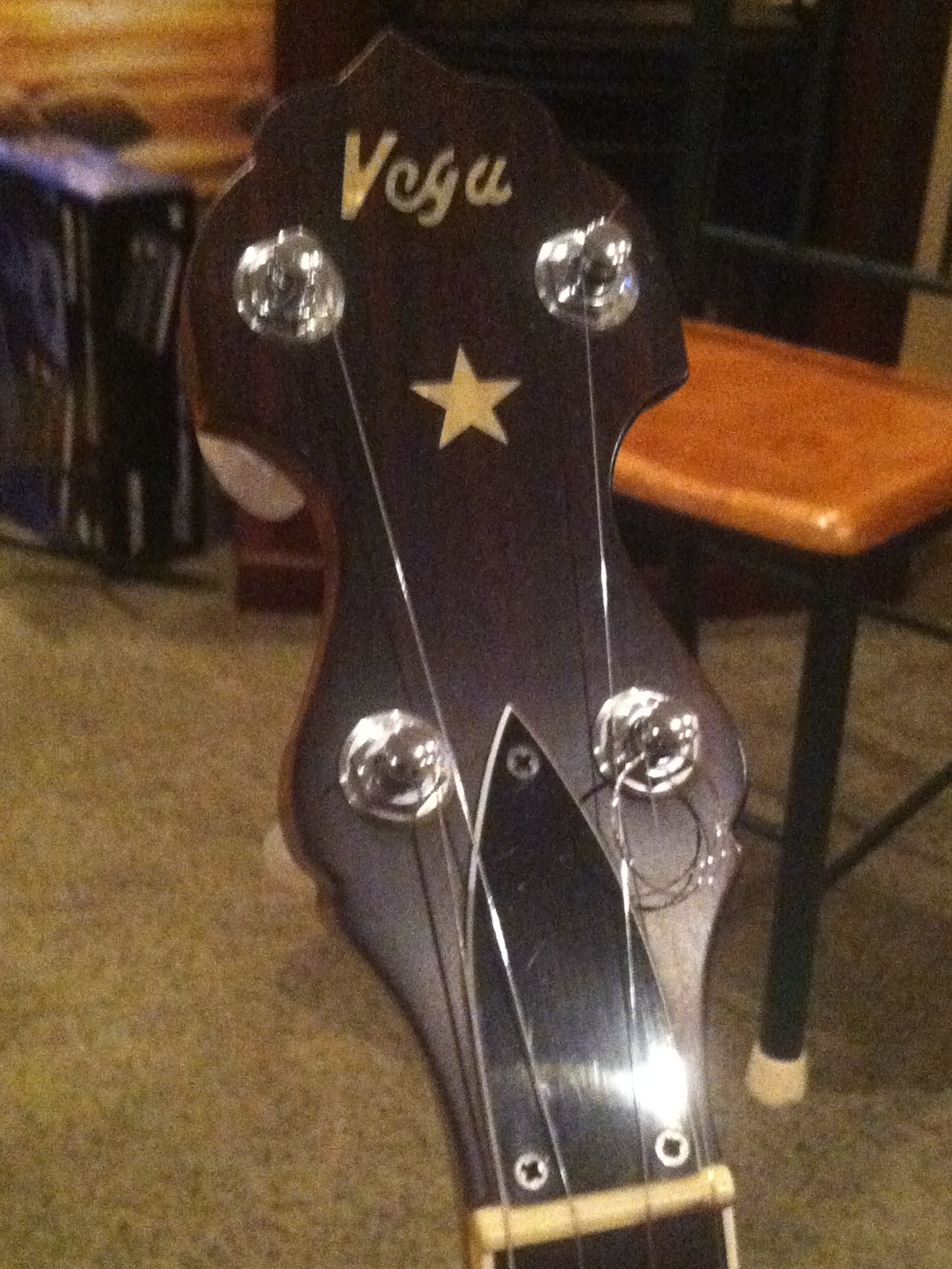
Answer: Tu-Ba-Phone 5-String made 1978-1979.
THE BRC THANKS YOU FOR VISITING THE VEGA MARTIN BANJO INFO PAGE
Below are more Letters from the BRC Archives. Enjoy.
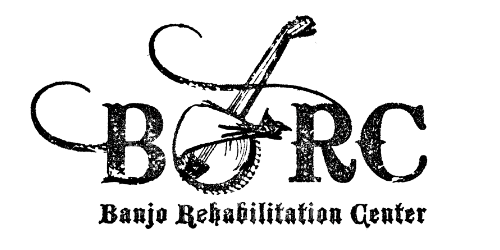
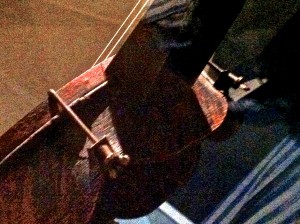
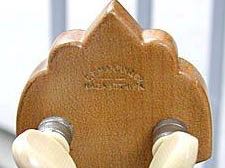
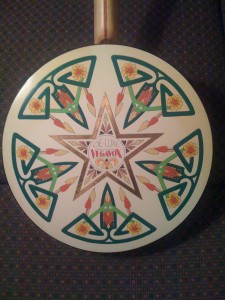
![Unknown-3[3]](http://www.banjorehab.com/wp-content/uploads/2016/01/Unknown-33-300x225.jpeg)
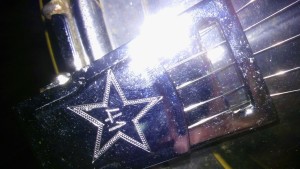
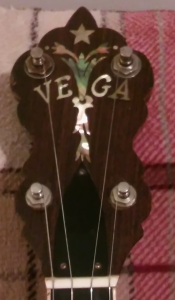
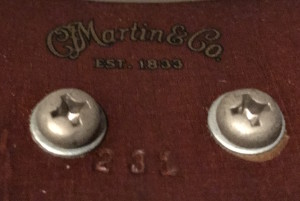
29 Comments
I’m happy to find Banjorehab as it is the first site I’ve seen to have useful information on Vega-Martin banjos. I’ve owned one for 30 yrs though I don’t play it very well. The neck has crown-and-football inlays and the Martin logo is on the back of the pegboard. On the inner rim of the back cover is another Martin logo and the (embossed in white) number 887. I’m assuming this is the serial number, which would put me right next to Mark, who owned #888 in previous comment 6. Is 887 also a Pro5? I purchased the instrument from a private dealer (Kingsport, TN) for $800. The story he told was that it was a “distress sale” for a friend, and that the banjo was one of 1000 limited editions and had a “solid silver” tone ring, and was worth at least twice the price. Having read the posts above I see that this is most likely not the case! However, it’s a beautifully crafted banjo with a great sound. I’ve had several accomplished pickers really make it “talk”….wish I could!! Would appreciate any information you can provide to verify the model and any original cost/current value. Excellent condition. Many thanks and keep “pickin’ & grinning”.
Mike- Thanks for your post and kind remarks about the BRC website. Like Mark whom you cite from Comment #6 above, your banjo is one of 14 Pro-5 instruments manufactured per Shop Order #2197 in 1974 in Nazareth, PA. Martin built 100 Pro-5 banjos from 1971-79, including the whimsical “Bobby Joe Fenster” 5 stringer which was a thinly disguised Pro-5. For a chuckle, see the latest home page entry for BJF details. The Pro-5 model had an improved bell brass tone ring (alas, not silver) with exclusively designed audio apertures, a thick 10 ply wood rim, a double-tension neck rod, a notched brass tension hoop, nickel plated parts, a mahogany shaded finish, and white binding. The VM price list in 1971 quoted a sales tag of $545 for the Pro-5 without case. These days, my guess is that this 5 stringer is worth about $1500 or more depending on condition. It is indeed a sweet banjo with plenty of “talk” in it. Thanks again for your query, Barry
The top-of-the-line model that Martin-Vega offered during the 1970s was the special order Ultra Vox V. At the end of the production run in 1979, the MSRP list price in the catalog was $3600 (exactly the same as the Martin D-45 guitar). The original prototype was designed and built by the Vega Company in 1969, for the legendary “King of the Banjo” Eddie Peabody to commemorate his 50th year in show business.
The banjo shown here (serial number M130316) was the second Ultra Vox V built in 1971, shortly after C.F. Martin’s acquisition of Vega of Boston…and, the only other one completed in the old Needham Heights factory before banjo production finally moved to Nazareth. This instrument was a special order for banjoist, Jack Mistretta, from Grand Rapids, Michigan—who happened to be a friend of Eddie Peabody. As such, it is also unique in that is the only Ultra Vox V to be modified and finished by Peabody’s other ex-Marine buddy and master luthier, Larry Kellens (widely known as the “Vega Doctor” during the 1950-70s). This banjo has all hand-machined bell brass parts to replace the cheaper, more commonly used aluminum alloys used by both Vega and Martin during that era (including coordinator rods, top-tension rim lugs/shoes and bolts), and Kellens’ other signature upgrades that includes an 1/8” brass shim between the heel of the neck and rim and lacquered, highly polished inner resonator to enhance tone depth and volume projection. The flanges, tension hoop, tailpiece and extended armrest are deeply and elaborately engraved, and were originally finished in a special hardened 24K gold electroplate. The rhinestones on the flanges, tension bolts, and peghead differ from Peabody’s prototype and the later Martin production Vox V models. All of these extra upgrades were reportedly worth an additional $1000 at the time.
After the original owner, Jack Mistretta, passed away in 1998, this banjo found its way to Japan, where noted jazz-banjoist, Ken Aoki, featured it for many years in his touring act. Despite showing its age as a workhorse performance instrument with extensive wear-and-tear, a friend of mine in San Diego purchased this one-of-a-kind banjo in Vega and Martin history in 2007 and had it beautifully restored to its current condition by the American Banjo Hall-of-Fame member, Renee Karnes.
The Vega Ultra Vox V is among the rarest of the limited, special order edition banjos made by either Vega of Boston or Martin. While published accounts indicate that only 18 plectrums and 3 tenors were made in this series, Martin company officials have shared information from current records that one-third were simply shop orders that were never actually completed in the post-strike period. The last two Vox V’s (serial numbers 1964-1965) were built in 1979, and still exist to this day.
Dr. Ron- the BRC staff and readers appreciate all the wonderful details and photos. Thanks from all of us! Barry
I inherited a Vega 5-string resonator banjo and have been trying to find out additional information about it. I has Vega and a single star on the front of the headstock. There is a star on the 5th fret. The back of the headstock is blank. The inside of the banjo is also blank except for the painted serial number 2207. There are no other identification markings on the instrument and it definitely does not say Martin anywhere. It is in pristine condition and is clearly a very high quality instrument. It has the original hardshell case also with no markings. Any clues? Photos are available.
Martin- Thank you for your query and very useful photos. The Martin Co. sold the Vega franchise to the Asian conglomerate `Galaxy Trading Company` in 1979, and thereafter Vega banjos were manufactured in South Korea. The serial numbers for the overseas-produced instruments were in the 2000+ range in sequence with the last official VM banjo manufactured in Nazareth, PA, which bore #1969. Galaxy marketed its 4 and 5 stringers in the USA via a remarkably unimaginative TMC catalog in which each banjo was identified only with an Item number but no model moniker to give it personality like the “Pro-5” or “Wonder” banjos named by the earlier corporate owners. Galaxy went bankrupt around 1984 and vanished. The rich heritage of Vega was derelict for 5 years until Deering rescued it by acquiring rights to the brand name in 1989.
Your banjo is an off shoot of the classic “No. 2 Tu-Ba-Phone” model which is part of an historic production series started in the 1920`s in Boston, continued in Nazareth, PA, and sustained today by Deering in Spring Valley, CA. Your 5 stringer is cited only as Item VDX75C in the 1979 TMC catalog where to retailed for $475. It looks like a well-preserved and fun mid range banjo waiting to be enjoyed by an appreciative musician like yourself. Best wishes for happy pickin`, Barry
I have an Vega 5-string banjo, open back, bought around 1965. It has no rod in the drum.
A sticker inside says “The Vega Co. Boston 15, MASS, Patended USA” The serial number is A-125394. Then by ink it´s written “Folk Ranger”. The Vega name on the head is not with the usual letters and there is no “star” there either. I bought it in Stockholm, Sweden as a student, so it was not so expensive, as i remembered. Is this an “old” genuine Vega in the lower price class”
Sten- Thanks for your query about the FR-5 banjo. The “Folk Ranger” was a no-frills entry level banjo that Vega made in response to the folk music revival era. Your banjo was built circa 1964, and the “A” pre-fix to the serial number means `adjustable truss rod`. Being a low end instrument, the early FR-5 model had no connecting rod. By the mid 1960`s, it was usually manufactured with a connecting rod. The Ranger sold for $125 in 1961 and $158 in 1966. The model was discontinued after Martin Guitar bought Vega in 1970. Your description of your FR-5 sounds like you have a genuine Boston-made Folk Ranger. Go online to `Images for Vega Folk Ranger banjo’ and enjoy (but don`t confuse your FR-5 with its cousin the Folk Wonder model FW-5). Thanks for your post. Barry
sir- need some help. Just bought a martin-vega banjo from an old man in North Carolina. It is the first martin-vega I have ever seen in person, or had in my hands! I think i’m in heaven. Can`t find anything about it on line. If anybody can shed some light on what I have. The only serial number is 1120. Also, the banjo has some ornate details carved in it. Is this original?
P.S. Guess I stated it wrong, not really carvings, just in lays. I gave alot of money for this, just hoping a made a decent deal. If you could give me your thought about what its worth, I would appreciate it.
Barry- Thanks for your queries and subsequent photos that promt me to revise my initial response. Despite its puzzling serial number, your instrument is a Tu-Ba-Phone Deluxe 5-string. This classic and ornate Vega series dates back to the 1920’s but did not appear in the 1970 and 1972 Vega Martin catalogues. The long-neck No. 2 Tu-Ba-Phone XL is seen in the 1976 catalogue. The rare T-2 and T-2XL had serial numbers in the #1607-1945 range. The beautiful Tu-Ba-Phone Deluxe and its plectrum and open back permutations appear only in a 3 page marketing pamphlet issued by C.F. Martin in the 1970’s (I have sent you the title page illustrating your instrument). Your peghead and resonator are clearly marked with “C.F. Martin”, but I do not detect such an identifying decal near the serial number on the interior of the rim. Hence, my theory is that this ornate banjo was assembled overseas after Martin began shipping parts to Japan and Canada for assembly in 1976, and this would explain the mysterious serial number. My estimate would be that this rare and exotic bird might fetch around $1800 or more these days. Hope this helps and thanks again for your post and e-mails, Barry
Lynne- Thanks for your query. To generally confirm that your banjo is a Nazareth built instrument, check for a “C.F. Martin” decal on the back of your peghead and on the inner rim. Banjo SN 1648 is a `Folk Wonder` model (FW-5) which first appears in the Vega (Boston) catalogue in 1961 per my files. Your banjo was manufactured in Pennsylvania in 1976 per Shop Order #2299 just before Martin began to ship parts to Japan for assembly (after which serial numbers became goofy). In a 1971 price list, the FW-5 sold for $345. The Folk Wonder is an open-back banjo that features a maple neck, a white bound ebony fretboard with pearl dots, and geared pegs in the headstock. The rim is 10 ply maple with a top metal tone ring, nickel-plated metal parts, and a shaded mahogany finish. The Folk Wonder model does not appear in the 1972 or 1976 Vega Martin catalogues, but its resonator version the `Wonder` model does. Deering (California) now owns the Vega brand name and produces a `Little Wonder` and `Old Tyme Wonder` 5-stringer not unlike your instrument. Photos are always welcome, and thanks for your post. Barry
Marc- Thanks much for the prompt and telling photos. Martin sold the Vega brand to the Asian conglomerate Galaxy Trading Company in March of 1979. Vega banjos were marketed in the US thereafter by TMC (Targ & Dinner 20 Century Music Company) via a catalogue published in May of 1979. The banjos advertised in the brochure had generic names and Item #`s. Your instrument was listed as “Vega 5-string Banjo” featuring a Tu-Ba-Phone tone ring with round holes thus representing “A reproduction of the early Tu-Ba-Phone No. 2” classic model. The Item # was VT2NRC. It retailed for $775 and was probably assembled from parts left over from Nazareth, PA. The Galaxy serial number is not a continuum of the Martin serial number sequence. Galaxy apparently went bankrupt around 1984 and vanished from the financial scene. Greg Deering acquired rights to the Vega brand name in 1989 and restored the banjo line to greatness. Again, thanks for your query and photos. Barry
I have an open back Vega long neck with “C F Martin Co” logo on the back of the machine head and inside the rim. The serial # is 448. I can’t remember exactly when I bought it but I think it was around the early 70s. What can you tell me about the history and value of this one.
Thank You
TH
Tom- Thanks for your query. Your instrument SN 448 is one of 11 Pete Seeger extra long neck (PS-5) models manufactured in Nazareth, PA, in 1973 per Shop Order 2153. It has the famous Vega `Tu-Ba-Phone` tone ring and notched tension hoop both made of bell brass, an ebony fingerboard, and a 10 ply maple rim. It retailed for $488 without case in the 1970 Vega Martin catalog, and it last appeared in the 1972 VM catalogue without a suggested price. In my files, the PS-5 model first appears in a 1961 Vega product flyer from Boston, but it may have been manufactured there starting in 1958. The Vega era PS-5 banjos sell for up to $3-4K these days. Vega Martin models (1970-1979) are less of a collector`s item and fetch about half that price range. Hope this helps and thanks for your post. Barry
My Vega VIP 5-string has S/N 2316 painted inside the rim, which I presume means it was assembled by Galaxy in Asia. The tone ring holes are grouped in sets of three rather than equally spaced as on a tubaphone ring
So here’s my question. How much Galaxy (or Martin) produce new parts vs. assemble old stock bought from Vega? I lived in Needham MA for 20+ years, and I’m wondering if that tone ring possibly came from Vega’s final days in Needham.
thanks for the very informative web site
Tim
Tim- Thanks much for your query. After Martin purchased Vega in 1970, the factory transitioned from Needham Heights to Nazareth, PA. The 1971-72 VM log books show 22 VIP banjos (most 5-stringers with a few tenor and plectrums) bearing the 6 digit Boston serial numbers, and thereafter the SN`s convert to digits #1 through #1969. My guess is that most of the left-over parts from near your home in Massachusettes were used up over the next ensuing 7 years of production, but there is an outside chance that a few spare parts like an occasional tonering survived and were transferred to Galaxy when it purchased Vega in 1979. As you have observed, the VIP tonering has holes grouped in threes, so maybe yours might be a lucky survivor from the early days of the VIP line when the model first appeared in the 1970 Vega Martin catalogue. The VIP banjo last appeared in the 1976 VM catalog as an open back instrument but still featuring the “V.I.P. tone ring” that you have. Thanks for your very kind words about the BRC website. Barry
I have 3 Vega banjos , 1963 Earl Scruggs model A 10921(Scruggs ST-5, handwritten in red ink under that on yellow label) which I played for 23 years, she has a very mellow sound.
I then discovered my Vega VIP Martin 1972 model #1766, a beautiful banjo which I have played for the past 12 years. I call him Rory, although much louder he has a beautiful rich tone, but is quite punchy..
I have recently acquired from Florida another VEGA Martin VIP model #845, which sounds totally different than the other 2, almost a rich full old timey sound yet with a resonator. i replaced the head but it still sounds the same. I’d appreciate your comments please & thanks, Linda.
Linda- Thanks much for your query and hearing about your three vintage banjos. Your mellowed 1963 SR-5 sold for $400 in the 1963 Vega catalogue, and it was advertised to feature a “brilliant tone” back then. Search online for “Earl Scruggs Vega Banjo Images”, and you will see a photo of him with his endorsed Vega instrument bearing the signature square inlays on the neck that offered its “distinctive stage appearance.” Your Vega Martin VIP-5 with SN 845 was made in Nazareth, PA, in 1974 as one of four manufactured per Shop Order #2193, and it sold for $556 without case in the 1971 price list (after which VM did not publish recommended retail prices). The VIP-5 is known for its mellow sound, and the tone of my VIP-5 (SN 1364 circa 1974) was admired by a faculty member at a northeastern banjo camp a few years ago. If you want a more Bluegrass sound, try a 5-Star head from Stew Mac. Your other VIP-5 with SN 1766 was assembled from parts sent to Japan in 1977 when the Martin company had its difficult luthier strike. Whenever parts are sent overseas, it is unpredictable if instruments are constructed fastidiously with matching parts, and this may explain the difference in tone between your two VIP instruments. Hope this helps, and thanks again for your post. Barry
I bought my Vega PS-5 S/N 1046 new in, I believe, late summer of 1974 through Miller Music in Lawton, OK. Dog-bone Tubaphone tone ring, Grover milk bottle guitar tuners. Still as wonderful as the day I got it. All original except the tailpiece cracked at the bend not long after I got it, and I replaced it with the Stew-Mac version. And recently I installed a new Elite head, which made a wonderful difference.
Micky- Thanks for your narrative on your Pete Seeger long neck. Your banjo with SN 1046 was one of five PS-5 instruments manufactured in Nazareth, PA, in 1974 per Shop Order 2218, and after that C.F. Martin made only about a dozen more PS-5 banjos. The last one was produced in early 1975 despite being their very first banjo made that year. The PS-5 appears in the transitional 1970 Vega Martin catalog, and again in the 1972 product brochure; but it is absent from the 1976 catalog. In the Boston era, Pete Seeger was listed as an exclusive Vega product banjoist in a 1961 flyer from their Columbus Avenue business headquarters, and his endorsed PS-5 was featured prominently in the 1963 and 1966 Vega catalogs. I have two Ode long neck banjos, and one of them is my daily practice instrument because of its wife-friendly tone. Thanks for your post and happy pickin`, Barry
Hello,
You are so kind to provide this great info to all of us banjo geeks. It took me six months to finally commit to purchasing the Vega-Martin VIP that I brought home today from a local music shop. I have two 1930 Vegaphones and an earlier Tubaphone conversion, and this VIP is certainly able to hold up its weight tone wise. Perhaps a bit more cutting. I am a fan of the 27″ scale and believe it has much to contribute tone-wise. I would love to be able to date this banjo: SN 999 as a decal under the Martin logo inside the rim with the Martin logo decal on the back side of the peghead as well. VIP is printed on the truss rod cover.
Thanks you for this great site. Knowing the history of an instrument adds so much to the enjoyment of owning and playing it.
Bill- Thanks for your query. Your instrument SN 999 was one of five VIP-5 (Very Important Player) banjos was made in Nazareth, PA, in mid 1974 per Shop Order # 2212. The 1971 Vega Martin price listed this model to retail at $556 without case. The banjo featured a bell brass audio-sonic tone ring, different from the tubaphone tone ring, and a ten ply maple rim. My VIP-5 is SN 1364 and was made about one year after your 5-stringer, and it has a nice mid range tone. If your Vegaphones and Tubaphone have serial numbers, you can more closely date them by visiting “Whitetreeaz banjo serial numbers” online. Best wishes with your VIP and thanks again for your post, Barry
I own a Vega VIP fivestring banjo, with serial number 130056. I would be grateful if you could inform me when it was made.
Kindly
Per Falt
Sweden
Dear Per- In May of 1970, C.F. Martin purchased the Vega brand line. The year 1970-1971 was a time of transition of tools and parts from Boston to Nazareth, PA. The last SN from Boston was probably #130049, and the Vega Martin logbook in Nazareth starts with SN 130248. The parts of your VIP-5 (Very Important Player) banjo # 130056 were probably manufactured in Massachusetts and assembled in Pennsylvania with a yellow data sticker on the inside rim and maybe C.F. Martin decals on the inner rim and back of the peghead. Thanks for your query, Barry.
Jim _Thanks for your query. C.F. Martin made 76 commemorative V-76 banjos in 1976 to celebrated the bicentennial of the USA. Martin also made 1976 model D-76 guitars to partner the banjo. Your 5-stringer was one of seven V-76E instruments manufactured per Shop Order 2310, and the `E` designation indicates that these seven banjos were made for employees. A total of 98 model D-76E guitars were also made for employees. There are 13 stars on the banjo fretboard, and there should be a plaque on the back of the headstock. For reference, the name of the original owner with serial number should be in the Martin Archives. C.F. Martin did not publish suggested retail prices after 1971, but I would estimate the V-76 sold for around $7-800 with case. Although mostly a collector`s item these days, the current price range of the V-76 is $2.3-5K. Hope this helps and thanks again for your post. Barry
Eddie- Thanks for your query and kind comments about the website. Your VW-5 model “Vega Wonder” banjo SN 721 was manufactured in Nazareth, PA, in late 1973 per Shop Order 2181. The Wonder series of instruments featured a metal tone ring, white fingerboard binding, a heavy notched tension hoop, a 10 ply rim, a 3 piece maple neck, a blackwood fingerboard, pearl dots, an armrest, and a factory-installed resonator with four section metal tone flanges. It retailed for $345 in the 1971 Vega Martin price list. Your VW-5 resonator banjo is not to be confused with its cousin the open back FW-5 model “Folk Wonder” which retailed for $280. C.F. Martin manufactured 561 VW-5 banjos but only 124 FW-5 instruments. Both the VW-5 and FW-5 appear in the 1961 Vega ((155 Columbus Ave., Boston, MA) catalogue but featuring a 5 ply rim in the early design. The open back Folk Wonder 5-stringer does not appear in the 1976 Vega/Martin catalogue where the Vega Wonder resonator series is still advertised. Hope this helps and best wishes from the BRC, Barry
Gary- Thanks for your query. Vega Martin long neck PS-5 banjo SN 80 is one of eleven Pete Seeger 5-stringers manufactured in Nazareth, PA, in mid 1972 per Shop Order 2098. C.F. Martin made 101 of the PS-5 instruments which listed for $488 without case in the final V/M price list in 1971. In my files, the PS-5 is seen in a Vega (Boston) flyer in 1961 where it lists for $309. In the 1960`s, the PS-5 featured a 3 piece ebony fingerboard and a “Tube-a-phone” tone ring of bell brass and a 5 ply maple rim. C.F. Martin upgraded the maple rim to 10 ply after purchasing the Vega/Boston franchise in May of 1970. The PS-5 is advertised in the 1970 and 1972 Vega/Martin catalogues but is absent from the 1976 catalogue where the No.2 Tu-Ba-Phone XL long neck premieres instead. In general, the Boston made Pete Seeger long neck banjos seem to command a greater collectors` interest than the ones manufactured in Pennsylvania. Again, thanks for your post. From the BRC, Barry
Thanks for the great information on this page. I have a Vega V.I.P. model serial number 1990. It is in excellent condition but missing a resonator thumbscrew with the threaded washer. Any idea where I might find one? Thanks Again!
Jon- Thanks much for your kind comments about the website. The last Vega Martin banjo manufactured in Nazareth, PA, was SN 1969 as reportedly documented by a letter of authentication signed by C.F. Martin historian Mike Longworth. You banjo parts were probably shipped in 1977 to Japan for assembly where all serial number assignments were in disarray. My guess is that the lugs in your resonator have American (inch fraction) thread features, and it is doubtful that an original VIP thumb screw 4 decades old will appear on eBay- but who knows. My suggestion would be to take you banjo down to the local hardware store and cobble together a workable thumb screw (some have collars) and washer combination. Good luck and thanks again for your post. From the BRC, Barry